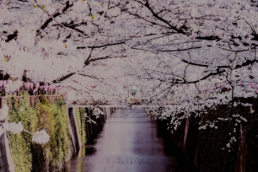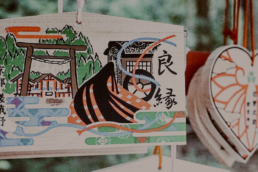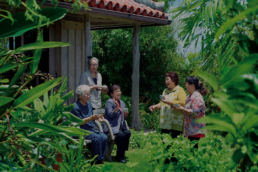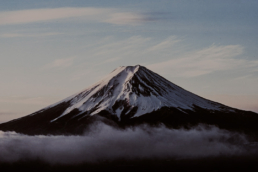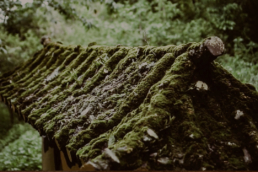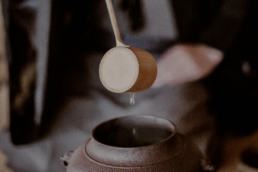Sakura, an in-depth look at the flower symbol of Japan
We continue our series of in-depth articles dedicated to the Japanese culture and today we talk about Sakura, the flower symbol of the Rising Sun. "The perfect flower is a rare thing. One could spend a lifetime looking for it, and it would not be a wasted life."
Sakura 桜 Symbolic flower of Japan
Guest Author: Flavia
This is how Ken Watanabe began in a scene from the famous film 'The Last Samurai' (2003) as the rebel samurai Katsumoto, against the backdrop of a beautiful Japanese garden. How could we not remember this scene from the film which, despite some historical inaccuracies, is able to give us moments like this. Surrounded by splendid trees in bloom, Katsumoto-Watanabe is simply staging the prototype of Japanese aesthetic sensitivity towards nature. In this case, towards flowers. But here we are talking about one flower in particular... the cherry blossom, an undisputed object of age-old admiration: the Sakura (桜 - さくら).
We are all familiar with cherry blossoms: their beauty is obvious, admiring them a natural consequence. This, I would say, needs no explanation. We can, however, talk about the particular importance of this delicate little flower in Japan, so much so that it has become a "moral" symbol (the official one is the chrysanthemum).
The term 'Sakura' refers to both the flower and the tree - known as the 'Japanese cherry tree' - a type of cherry tree characteristic of the Far East. There are about a hundred varieties of Sakura in Japan, including the big cities. But the most common are the Yamazakura and especially the (Somei-) Yoshino, with its typical pale pink-white colour, which has been admired by the Japanese for hundreds of springs.
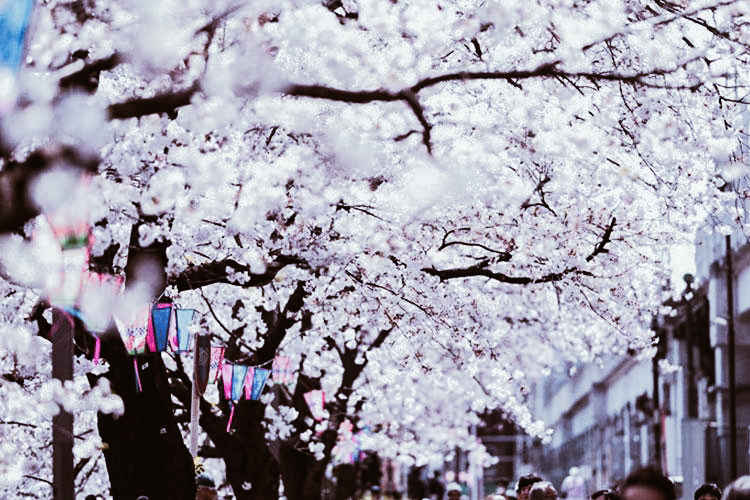
photo credits: japan.stripes.com
The Sakura is an institution in Japan, with its own special symbolism and deep meaning. It appears on the famous 100 yen coin and frames Fuji san, Japan's other great symbol, on the back of the current 1000 yen note. It is so popular that the National Meteorological Agency issues a special Sakura Zensen ( 桜前線 ) bulletin every year to update on the status of the flowering. The media informs the population daily about the best spots, so that they can adjust for the beloved Hanami (flower-gazing) activity, deciding where and what variety of Sakura to see.
Flowering proceeds from south to north, as the climate is milder in southern areas. So if you arrive in Japan when the flowering has already passed in the centre-south, look at the calendar, you might still be in time to catch them in Hokkaidō!
Mankai 🌸 Flowering
The average flowering time varies according to geographical location, but in any case it is short: a few days, maximum ten days. It starts in Okinawa, around the end of January, gradually moving northwards with the last buds opening around mid-May in Hokkaidō. This is the approximate time period. Bad weather, disturbances or sudden changes in temperature can obviously affect the duration of flowering, given the extreme delicacy of the little flower. It all depends on the climate and the year: it can happen that the flowers bloom a little earlier or later, or that the blooming is interrupted by a sudden change in climate. The time of the flowering boom is known as Mankai (満開), which in fact means 'full opening'.
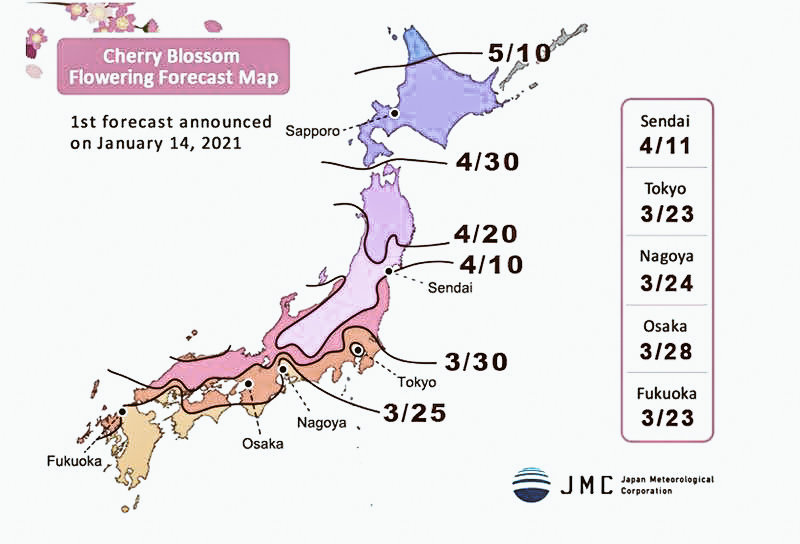
photo credits: japan.stripes.com
As mentioned above, most cherry trees are of the Somei-Yoshino variety, but there are over a hundred species. Some are even capable of producing edible fruit. Of the criteria for distinguishing between the different types, the most immediate is undoubtedly the number of petals, which can be ten, twenty or even more. The most common are the classic five-petalled Sakura, both wild and cultivated.
🌸 Types of Sakura
But let's look at some examples of more unusual cherry trees. In addition to Somei-Yoshino, the most cultivated and popular, we can find:
- Yama-zakura (山桜), the 'Mountain Cherry'. Very popular, it ranks right after Somei-Yoshino in terms of popularity. It has large pink buds and five petals.
- Fuyu-zakura (冬桜), or "Winter Sakura". As the name suggests, it is a cherry tree that begins to blossom in autumn and continues in winter, although not continuously.
- Yae-zakura (八重桜), the "Double Cherry Tree". So called because of its 'reinforced', i.e. very full-bodied, bud with more than five petals. It is associated with the ancient capital Nara (奈良).
- Shidare-zakura (枝垂桜), i.e. "weeping cherry tree" because its branches fall, like a willow, creating a cascade of pink flowers. It is the official flower of the Kyoto prefecture.
- Ichiyō (一葉), "a leaf". It owes its name to a leaf-like pistil that emerges from its centre when fully open. It is one of those that can have 20 to 40 petals.
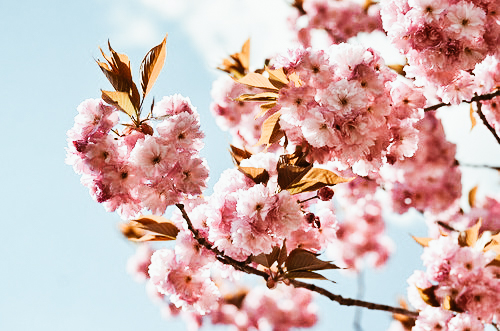
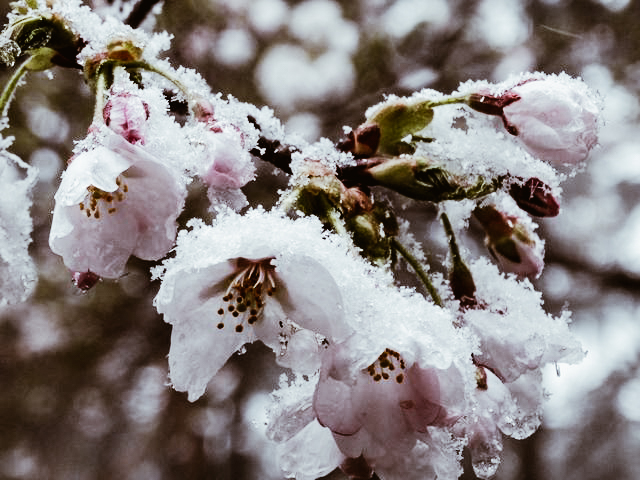

photo credits: Akemi K on Flickr, medigaku.com, Pinterest
Ippon-zakura (一本桜) are defined as all cherry trees planted "in solitude". These include Japan's three great cherry trees, the Sandai-zakura (三大桜). The trio consists of the Jindai-zakura in Yamanashi, the Usuzumi-zakura in Gifu and the Takizakura in Fukushima. Jindai and Usuzumi belong to the Edohigan variety (from which Yoshino is also derived), while Takizakura is a weeping cherry tree. In particular, the Jindai-zakura, located in the Jissōji temple (實相寺), is perhaps the oldest in Japan: it is about two thousand years old and has a circumference of 13 and a half metres!
Spring (春), season of hope
The act of contemplating trees in blossom dates back to the Nara period (8th century). Initially the prerogative of the imperial court of Kyoto, over the centuries it was extended first to the category of samurai and then to the rest of the population. Let us say that in the beginning it was the plum tree (梅-Ume) that was the object of attention. The plum tree represented the link with China, as it originated there. But already in the Heian period (8th-12th centuries), due to the interruption of relations with Middle Earth, the Ume was ousted by the more autochthonous Sakura. From then on, spring-themed poems began to refer to Sakura even only as "flowers" (花-Hana) and the word "Hanami" also became interchangeable with "sakura". Linguistic details, however, are indicative.
Spring (春- Haru) has always been characterised as a symbol of rebirth, of generating power.
In ancient times, the blossoming of cherry trees was associated with prosperity, as it presaged an abundant rice harvest. In order to propitiate a good harvest the following year, the beginning of the planting season was opened with a series of rituals ending with joyful celebrations under the Sakura. In the 18th century, Shōgun Yoshimune Tokugawa further promoted this custom by planting Sakura trees in various areas.
Today, spring is the season for students, graduates and undergraduates, who rely on the auspiciousness of the blossom. April marks the start of the new school year for students, while graduates and many school leavers are preparing to enter the world of work. April also marks the start of the new fiscal year in Japan. In short, the cherry blossom season brings with it some beginnings in that land. Therefore, it is duly celebrated with the Sakura Matsuri (桜祭り) festival.
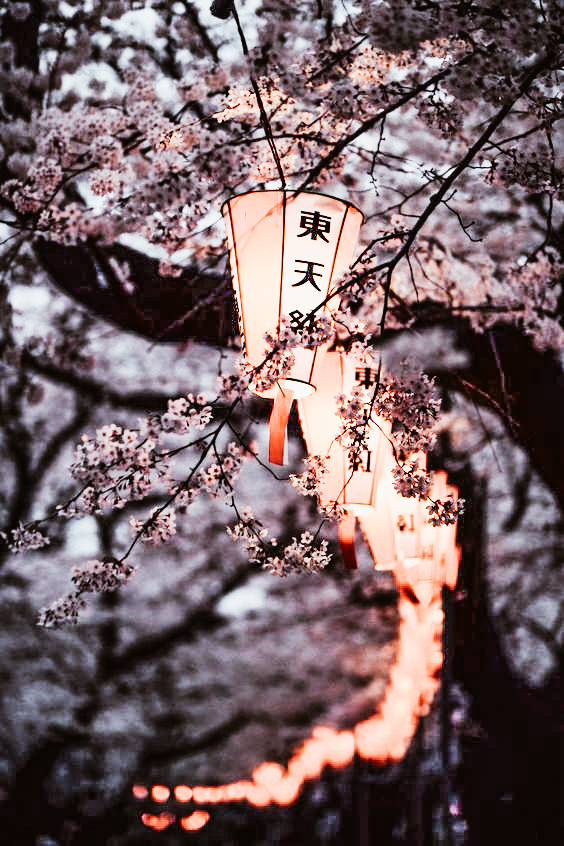
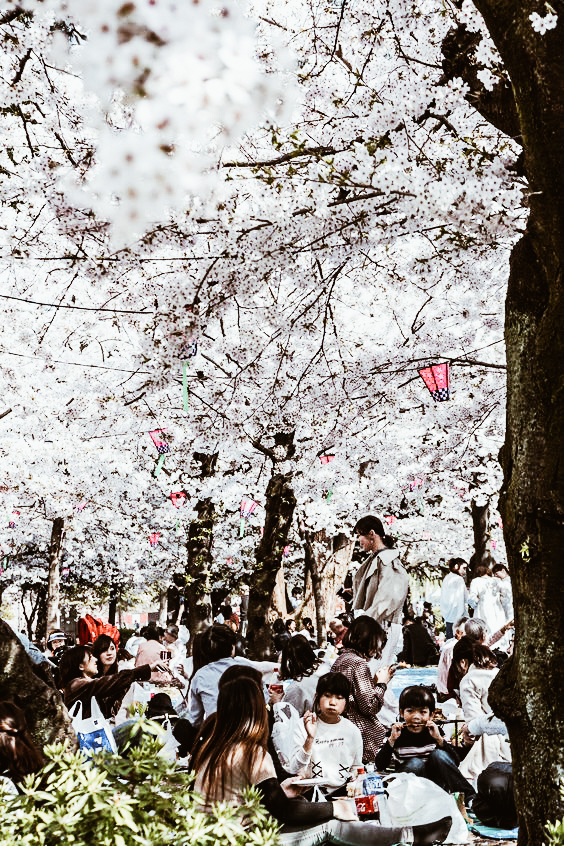
photo credits: Pinterest, Pinterest
Sakura in sweets and delicacies
Sakura and spring are also celebrated through food, in keeping with good Japanese tradition. Famous is the Hanami Bentō (花見弁当), or the bentō that is a must during a picnic under the cherry blossoms. For those who don't know, the bentō is a box for a picnic lunch, used by the Japanese all year round, but in this period it has a Sakura theme. You might find Sakura Onigiri (桜おにぎり) in there, for example, rice balls with salted Sakura on top.
However, there is also cherry blossom tea (桜茶, Sakura-cha), possibly combined with Sakura-Mochi (桜餅), a typical rice cake with red bean paste, wrapped in a salted cherry leaf. Sakura infusion is offered to newlyweds on their wedding day as it is considered a good omen. Wagashi (和菓子) - the traditional Japanese confectionery - come in a variety of sakura-themed varieties. Again, among the more commercial products: just as you can have Matcha-milk, there is also an all-pink Sakura-milk. And we could go on and on, but perhaps we'd better stop, otherwise our mouths will water too much!


photo credits: kitchenbook.jp, pinterest.fr
Hanami (花見), admire the buds
Hanafubuki (花吹雪): "snowy storm of buds". This is how the spectacle of falling petals from cherry trees in bloom is defined, whose rain colours the landscape in a kind of "spring snowfall". If one of these petals (花びら- Hanabira) falls into one's sake glass while making Hanami, it is a propitiatory sign of good health.
As mentioned at the beginning, the word "Hanami" means the practice of looking at cherry blossoms (花= flower(s), 見= watching). Nowadays, Hanami celebrations can range from simple picnics to more elaborate celebrations with music and entertainment. They can also take place at night, in which case, we talk about Yozakura (夜桜) or "sakura by night". The result, you can imagine: an evocative nocturnal Hanami, amid paper lanterns and moonlight.
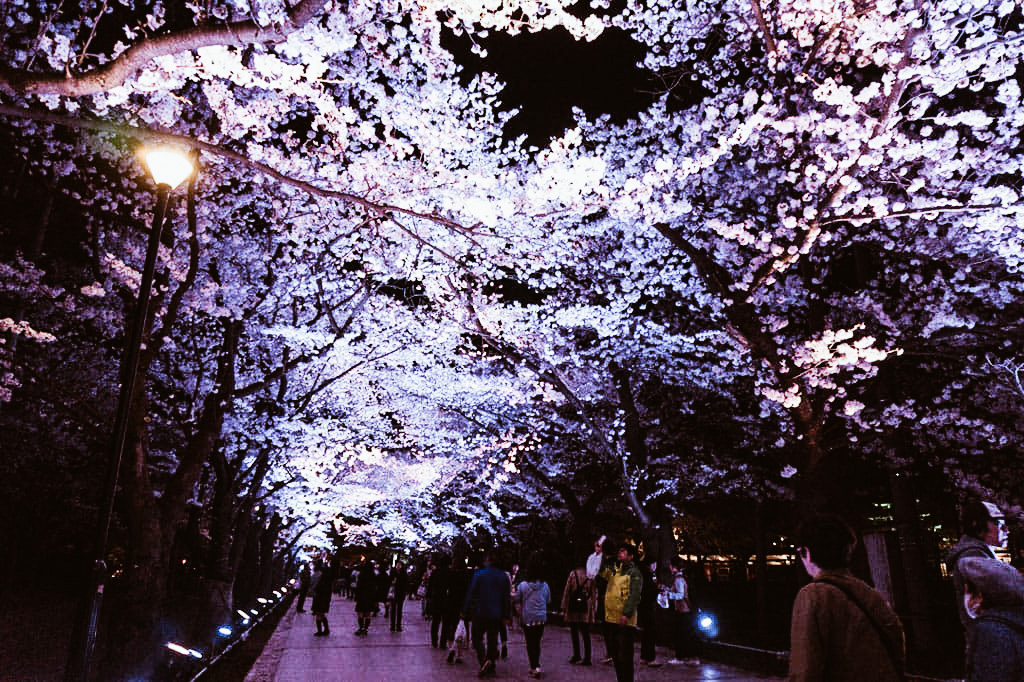
photo credits: power-shower.com
However, the peculiarity of Hanami is not in simply witnessing this spectacle of nature: it is in assisting it by capturing its fleeting appearance. The beauty of the buds also lies in their transience. In those who contemplate them, a feeling of sweet melancholy arises... which the delicacy of these flowers is able to evoke when, having detached themselves from the tree, they float carried by the wind or a delicate breeze, to then settle on the ground. An emotion given by the realisation that this is nothing other than the ultimate nature of human existence itself: destined, sooner or later, to have an end.
"So I come to this place with my ancestors and a thought comes back to me: like these sprouts we are all dying... recognising life in every breath, in every cup of tea, in every life we take away... " [ Katsumoto Moristugu - The Last Samurai ]
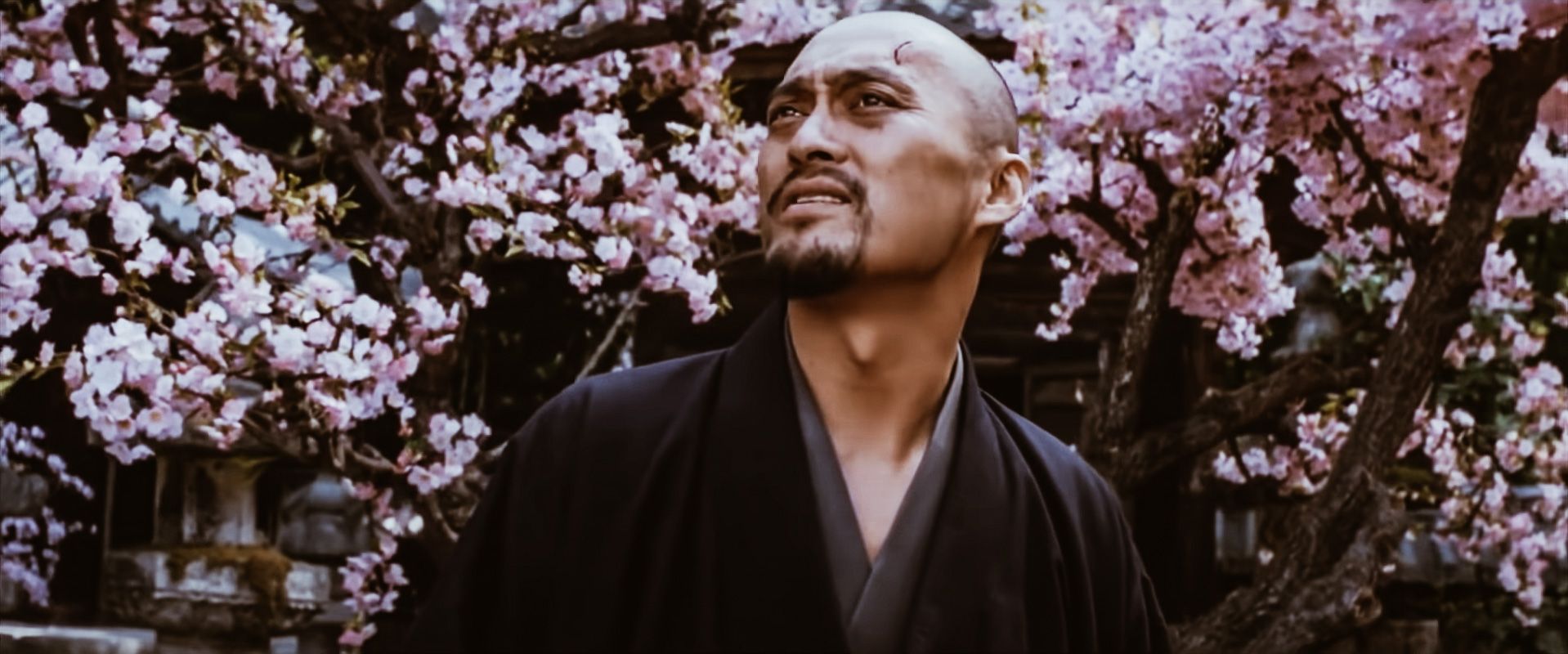
photo credits: YouTube
Symbolism of Sakura: mono no aware (物の哀れ)
The symbolism of Sakura is therefore both sweet and bitter, but this should not surprise us, as we are familiar with the Japanese feeling of "Mono no aware". In other words, a "pathos for things" characterised by a delicate hint of nostalgia, due to the awareness of their constant change. A concept that our Sakura embodies to perfection and of which he inevitably becomes the spokesman. Its beauty is enchanting but evanescent, ephemeral. So contemplation becomes sweet because of the delicacy of the flower, but also melancholic... because it is aware of its evanescence. Thus we contemplate its splendour but with an aftertaste of sadness. In a few words, this is the essence of Sakura.
Once again we are faced with an aesthetic that transcends the exterior. An exterior whose beauty hooks individuals, then leads them to a wider form of contemplation. We have seen this well, also in our article dedicated to Wabi-Sabi 侘寂. This has never been more true than in the case of the Sakura.
Cherry blossoms thus symbolise the transience of life and cyclicity. Because they blossom in all their glory, but their show remains for a limited time. The transience of life, youth and beauty: a metaphor that nature itself seems to want to offer every year and which Japan has been particularly careful to capture. At the same time, however, they are also a symbol of (re)birth and hope... because every year they come back to bloom in all their splendour.
Wonderful and a symbol of vitality on the one hand, extremely fragile on the other: this is their dual nature. Given this awareness, the reference to Buddhism is inevitable.
Symbolism of Sakura: other meanings
Other more specific meanings attributed to Sakura have to do with the number 5. So, naturally, it is the classic five-petalled cherry tree that best lends itself to this type of symbolism. The number 5 is said to recall the Japanese cosmogonic myth (about the birth of the 'cosmos'), according to which there were originally two gods, Izanagi and Izanami, who fathered five children; the birth of the fifth child, the god of fire, would prove fatal to the mother-goddess Izanami. Izanagi, distraught, thus killed this son, from whose parts the mountain gods would then originate. The number 5 also refers to the Japanese esoteric Buddhist concept of the five orientations (cardinal points plus the centre) and the five elements of water, fire, earth, ether and vacuum.
More generally, cherry trees can also be associated with clouds simply because of a visual issue: their mass blossoming can be reminiscent of clouds in the sky. A bit like the expression 'Hanafubuki' we saw earlier, where fubuki (吹雪) alone means 'snowstorm'.
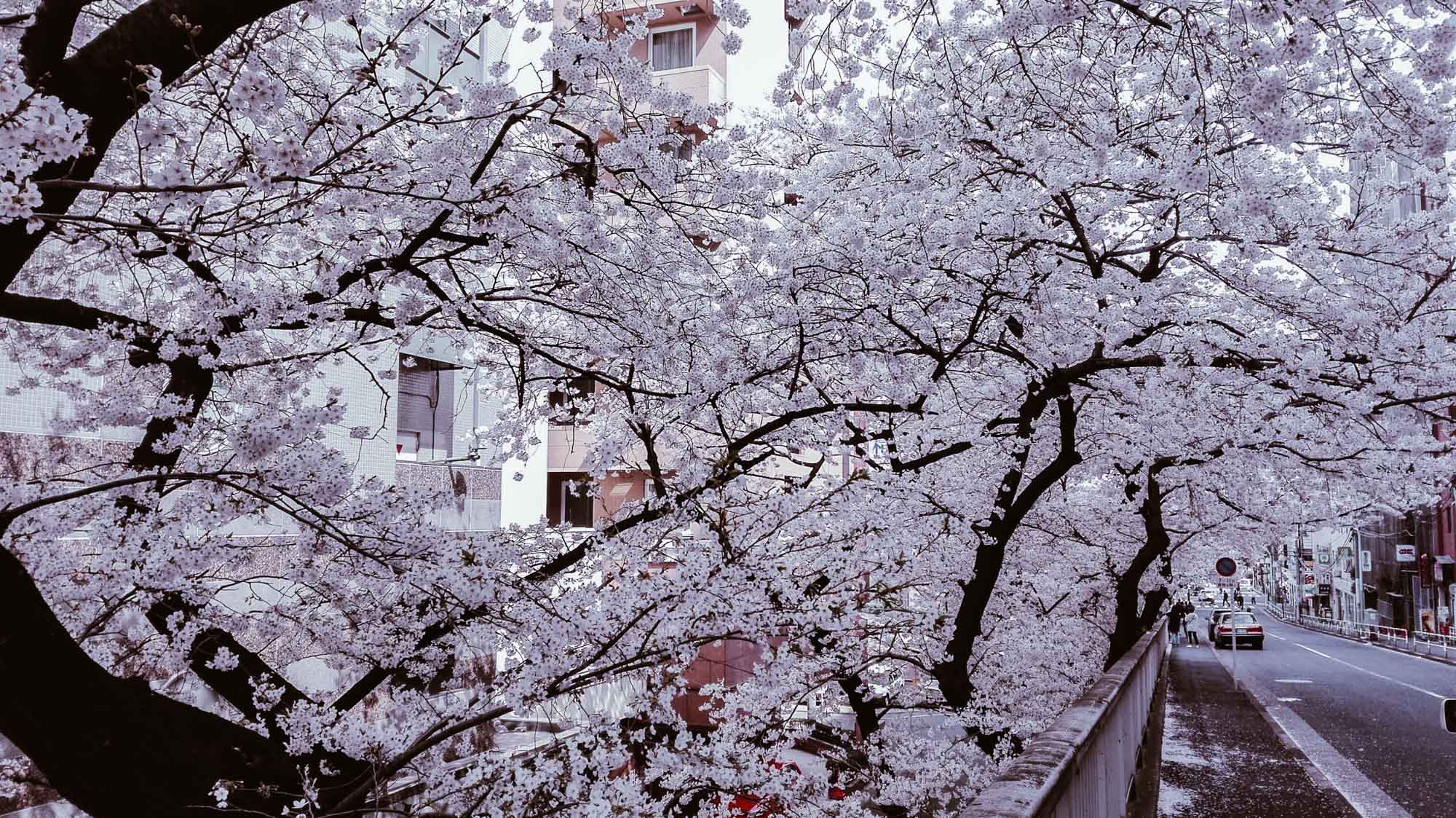
photo credits: Flavia
As the Sakura, so the Samurai
But back to our Katsumoto-Watanabe, his sentence actually ended with "...this is Bushidō". In fact, Sakura was also associated with the ideal of the way of the warrior and the figure of the samurai (侍), so much so that it became the emblem of the category. You will say, where is the similarity? In the fact that the cherry blossom embodied the qualities typically associated with the samurai (courage, purity, honesty, loyalty...). As the Sakura dies at the height of its splendour, so the samurai at the height of his vitality and strength was ready to die if the time came. In this sense, his life, however grand, was as fragile as that of a cherry blossom. However, he was not afraid of death, since it was experienced as a last ideal act and the only possible honourable end, in the name of extreme loyalty to his values.
In the cherry tree, the bushi (warrior) found his model and identified his life with it. Just like the delicate little flower, he had to lead his existence giving his all, through dedication in every gesture, until his last sigh. All that mattered was to "burn" as much as possible through that fuel, which was his life force. In all this, there could be no room for the fear of death. On the contrary, it was in the warrior's last moments that his beauty shone brightest.
So the Sakura, so the bushi: just like in the proverb "Hana wa sakura-gi, hito wa bushi" ( 花は桜木-人は武士 ) that is "Among the flowers the cherry tree, among the people the warrior". The samurai in battle could fall under the blows of the opponent, just like buds that fall to the ground detached from the branches by a gust of wind or rain. Just like so many small, triumphant buds, the samurai flourished, only to meet their fate.
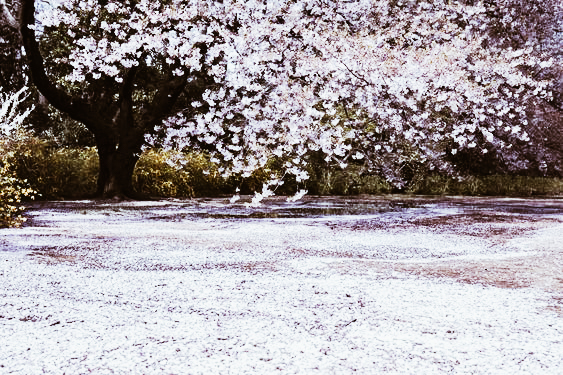
photo credits: Pinterest
This identification was also used in various ways by Imperial Japan centuries later. Among others: the Sakura was reproduced on the sides and in the name itself of the Ōka ( 桜花 ) airplanes to symbolise the extreme act of the Tokkōtai (Special Attack Unit) Kamikaze at the end of World War II. The pilots themselves, on the verge of their suicide mission, are said to have embarked carrying a cherry branch.
Nowadays, the Sakura may symbolise the martial arts.
"Woman sitting under the cherry blossom trees"
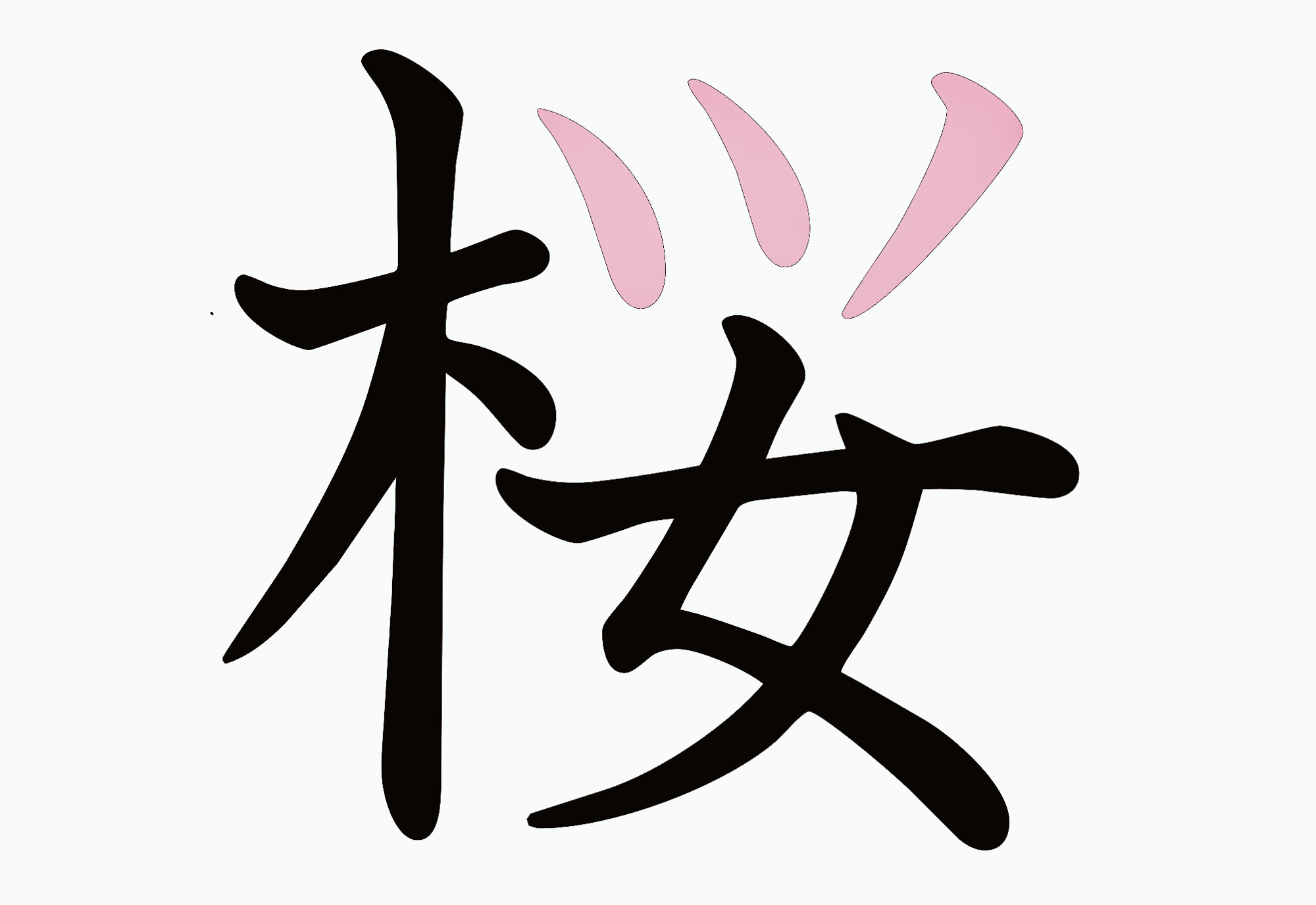
photo credits: appareassociazione.blogspot.com
This is the image that could be drawn - certainly the one I see - by observing the ideogram of "sakura". This is far from being the explanation why the kanji 桜 has this specific form, but it lends itself well to such an interpretation. Especially given its present simplified form. Before leaving us, we cannot conclude without a parenthesis on the writing and the cherry tree kanji.
As you can see in the picture above, Sakura's ideogram 桜 is composed on the left of the radical 木 (=tree), on the right of three dashes with the character 女 (=woman) below. The little part in pink, tell the truth: doesn't it really resemble the petals of a flower?
Actually, this part used to be written in a more elaborate way and had nothing to do with the meaning. It was written like this: 櫻. Later on, it underwent a process of simplification, like so many other ideograms in both Japan and China (where they come from). Bearing in mind that ideograms derive from pictograms, let us observe our character in its transition from pictogram to ideogram in the images below.

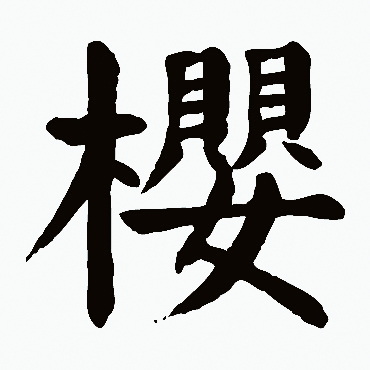
photo credits: shufam.hao86.com, shufa.m.supfree.net
This was its transition, and then in more modern times it changed exactly as follows: 櫻 🡪 桜 (in China it became 🡪 樱 ). The double 貝貝, which preceded the present three hyphens, indicated "necklace"; while the single 貝 still means "shell". So you see how, by investigating the Chinese etymology, the real historical evolution is revealed. Be careful, however, because the whole right-hand side (i.e. 嬰) of the ideogram 櫻 has reason to be there solely for a phonetic reason. (Not for reasons of meaning, which is also different between Chinese and Japanese). That is, that part has been "put" there to give the pronunciation to the kanji 櫻 as a whole.
But beyond this brief digression, we still like to see it like this: like a little woman under a flowering tree. Right? Since we are dealing with the simplified character today, we can safely indulge in this reading of the kanji which, coincidentally, is very reminiscent of the image of a woman under the blossoming cherry trees. And it certainly helps a lot to remember the ideogram. After all, this flower also recalls femininity. It is no coincidence that Sakura, or the variant Sakurako (桜子or 櫻子), are quite common female names in Japan.
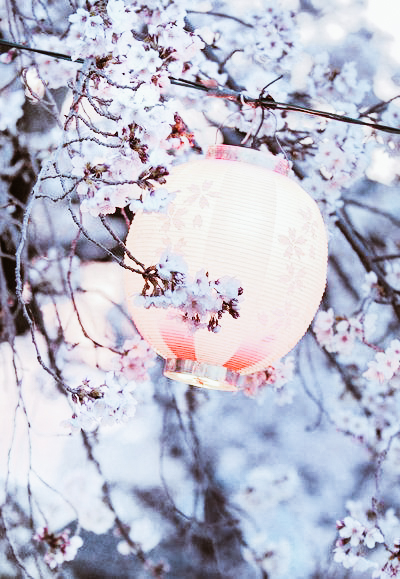
photo credits: pinterest.it
Ema tablets and the temples of Japan
The Japan Italy Bridge column continues to promote in-depth studies related to the world of Japan, today we talk about the Ema Tablets that we find in all the temples of Japan.
Raise your hand if you've never seen these curious wooden plates in an anime. Perhaps in a Shinto shrine, with a miko - the priestess dressed in red and white - going about her business. In any case, whether you've seen them before or not, today you can find out more.
Ema 絵馬 Japanese wooden votive tablets
Guest Author: Flavia
Translated as 'Horse Representation', Ema's are flat plaques designed to transcribe wishes and fears to be addressed to gods/spirits (kami) and buddhas. In other words, they represent a way for people to write a little message to the spiritual world. Formerly made of clay, they later began to be made of wood. Once a prayer has been written, the Ema is hung in a dedicated space at Shinto shrines as well as Buddhist temples. It is in fact a custom of Shinto origin that later spread to temples. Since they are all displayed together 'publicly', anyone can of course take a peek at them (it is important that the kami do the same).
However, it is also possible to keep them for oneself, as an heirloom. The great variety of representations, colours and styles that characterise them has always attracted the curiosity of folklorists. Together with the inscriptions on them, they represent a veritable prism through which a wide range of life stories are presented to us. A cross-section of spirituality that can show us the different colours of Japanese reality.
Ema are not the only religious objects designed to 'operate' in this sense, but they are perhaps the most widespread and can be found just about everywhere. The fact that they can be left in place distinguishes them from other religious objects such as Fuda (札) and O-Mamori (お守り). With an average width of 15 cm and a height of 9 cm, they can be very varied in size, shape and colour.
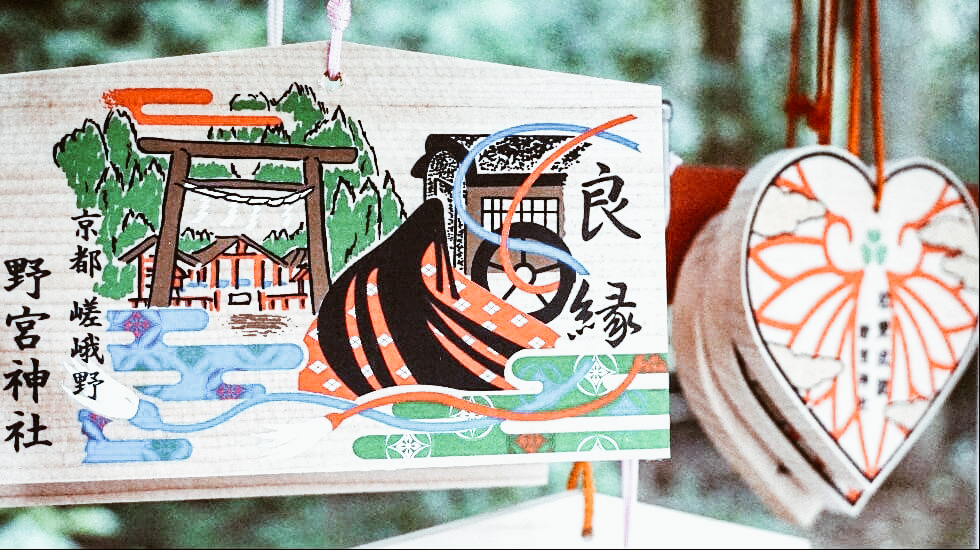
photo credits: sharing-kyoto.com/
The themes depicted can range from the following:
-
- the kami/buddha to whom the shrine or temple is dedicated (there may even be tablets depicting Thomas Edison!)
.
- the specific benefits that kami (spirits/goddesses) and buddhas are empowered to bestow;
- scenes on the origin and history of the place of worship;
- religious or cultural objects, such as zodiac animals of Chinese origin (some shrines are specifically dedicated to an animal-sign of the zodiac)
.
However, traditionally, particular importance is given to the representation of the horse, as suggested by the etymology of the name itself: e (絵) "image, drawing", but (馬) "horse".
Why the horse?
Short answer: because in ancient times people used to offer a horse to shrines and temples to obtain blessings and good luck. The figure of the 'sacred horse' still survives to this day, so much so that some religious centres use to keep one. And, if not in the flesh, in the form of a life-size model.
This sacredness of the horse originates from an ancient Shinto belief that saw the horse as an animal dear to the kami and as their messenger (although it is also important in Buddhism). One thing led to another, and so the horse quickly became a symbol carrying messages between the human world and the "other side". Or the Higan (彼岸) as it is also called in the anime/manga Noragami. (Noragami is highly recommended if you are attracted to the 'spiritual' genre, so to speak. Even through the author's fictional interpretation, it gives you a religious insight into Japan, and renders very well the relationship of the Japanese with spirituality).
Anyway, having established that our horse was considered special, the idea was to invoke a 'hand from heaven' in troublesome situations or events. For example, in times of drought they hoped for some rain (black horse) or, if not, for it to stop raining (white horse). However, in ancient times only a few people could afford to give a horse away easily. The majority of people tried to hold on to them as a valuable animal for their livelihood. Moreover, as the academic Ian Reader notes, such offerings could also prove costly for the temples if, at every prayer of some rich lord, they found themselves with a horse each time, which rightly had to be maintained, with the expense that this entailed.
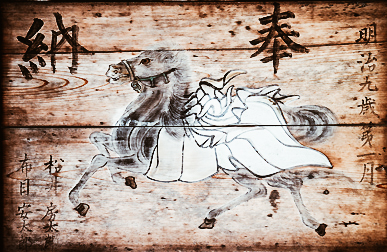
photo credits: japan-photo.de
It was in response to these contingent problems that the idea of depicting the horse began to emerge. Instead of using the animal in the flesh, why not make 'e-ma' ('horse-image') instead? An affordable solution, accessible to all.
Ema thus made their first appearance at the beginning of the 8th century (Nara period), while the first evidence comes to us from the mid-10th century (Heian period). The collection of Chinese poems and prose Honchō Bunsui or Monzui ( 本朝文粋 ) would be the very first work to mention the "ema". Many others would follow, one of which was the Konjaku monogatari (今昔物語).
E-ma: the origins of the tablets
.
Ema are said to have originated as a substitute for the horse in the act of conveying one's prayers to the supreme otherworldly entities. Although some voices have been heard to the contrary of this general line. Another reading of the events would in fact have it that the plates took on the definition "ema", simply because the horse design was more popular than other themes.
This is because the theme of the design changed depending on the request. Let's say that the design of an Ema was that of a horse: the requesting party's wish could concern the welfare of their horse (think of the case of the most humble, for whom such an animal was fundamental). If the wish did not concern a horse but, for example, a physical ailment, the design would depict the painful part of the body; and so on. So "ema" according to this view would not indicate that the tablets were given the same "agency" as the animal. Rather, it simply means that there were a lot of requests concerning horses, from which an extension of the designation would be triggered.
Another interpretation, however, emphasises that the sacredness of the horse is not a purely Shinto invention and that in Buddhism, too, the animal has its own significance. Thus, the origin of the Ema would perhaps be more to be found by looking back at the role of Buddhism, on which Japanese folk traditions draw extensively. In this regard, the scholar Gorai Shigeru saw a possible origin of the Ema in a particular folk custom, related to the Buddhist tradition O-Bon (お盆). This custom consists of carving horse forms from certain plants, again for votive purposes to the souls of the dead. Gorai seems to suggest that the origin of this custom may predate that attributed to the Ema or other similar forms of representation.
Both of these dissonant rumours about the origins of the Ema do not seem to be well supported by archaeology. In fact, the archaeological findings all seem to confirm the hypothesis of the need for an alternative means of transport to the horse, which at the same time 'took its place'. Something equivalent, embodying its spirit, its symbol: its image.
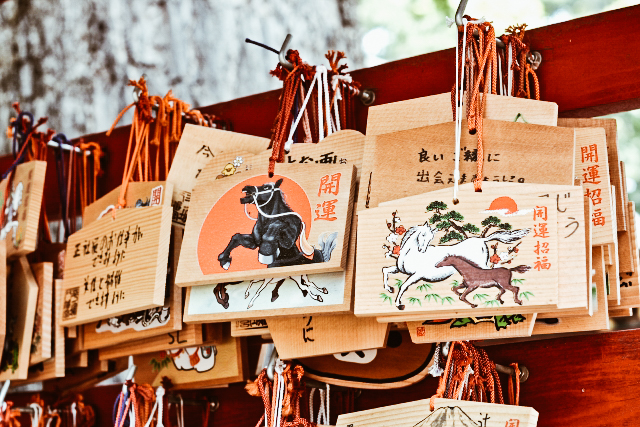
photo credits: shrine-temple-navi.jp
Ema as 'living objects'
.
The proof of this would come from the language itself. There are numerous ancient inscriptions on Ema that, from a linguistic point of view, unequivocally refer to the tablets as if they were talking about the horse itself. Let us look at some of them.
In the aforementioned Honchō Bunsui there is a reference to the Ema containing the symbol 匹 ("hiki", "biki" or "piki"). Reporting from the Reader, the expression would be: "色紙絵馬三匹 "or" 3 coloured sheets of horse pictures". Nowadays used as a counter for small animals, in Old Japanese the ideogram 匹 referred to stable animals, including horses. The combination of the word "ema" with this linguistic particle, whose function is to designate a living being, speaks volumes. Similar inscriptions have also been found in two shrines in Yamagata and Saitama, dating back to the 16th and 17th centuries. In this case, we find the ideogram 疋 instead of 匹, but the meaning and reading are the same. Again from Reader, it is: "shinme ippiki" (神馬一疋) and "ema ippiki" " 絵馬一疋 ". That is, "a sacred horse" and "an image of a horse".
However, although the hypothesis on the possible Buddhist origin of the tablets was not solid, Buddhism at least in retrospect is certainly present, given the Japanese syncretism. Among other things, in the temples, the Ema serve as a means of transmitting Buddhist religious doctrine, thus assuming a further function beyond that for which they were born. We are talking about those teachings about the importance of altruism or compassion (understood in Buddhism as 'empathy') or through images taken from stories about the Buddha. Although not entirely certain, it is estimated that the adoption of tablets by Buddhist temples began roughly between the 12th and 14th centuries (Kamakura period). Indeed, many of the Emaki - scroll artworks - of the period depict the Ema or horses themselves, both in Shinto shrines and Buddhist temples.
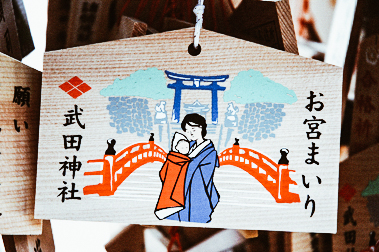

photo credits: japan-photo.de
Wooden tablets as an art form
.
Over the centuries, the designs of the Ema became more and more elaborate and varied, giving rise to a true folk art form. In particular, the Ō-ema (大絵馬), or "big ema", proved to be an important step in the development of Japanese art. In fact, after the birth of the Ō-ema, several great Japanese artists would draw on the ema style.
Created between the 14th and 16th centuries (Muromachi period), these Ema were at least one metre in height and width. They were donated to temples and shrines as a sign of gratitude - even after the fact, not only at the time of the request - and were placed in special spaces, the Ema-dō (絵馬堂). The oldest Ema-dō seems to have been sponsored by none other than... Toyotomi Hideyoshi in 1606, for the Kitano shrine in Kyoto. Also in Kyoto, the famous Kiyomizu-dera (清水寺) has several Ō-ema, originally donated by merchants as thanks for the safe return of their trading ships.
The consequence of this artistic development was the emergence of a "caste" of artists specialised in ema painting, which flourished in the Edo or Tokugawa period. This period - of economic expansion, especially at the beginning - led to an increase in the demand for professionals, enabling them to make a living from producing small ema paintings alone.

photo credits: japan-photo.de
The Ema language: symbolism
.
It was during this period that most of the symbols and themes reproduced on tablets originated. But to what does this need to put thoughts and feelings on paper - or rather, on wood - owe? This need is rooted in the folkloristic belief that a desire has a better chance of manifesting itself in reality if it is expressed in words, because by doing so, it gives it form. We must also bear in mind that in ancient times literacy was reserved for a small segment of the population. An alternative language to words, immediately comprehensible to all, was, therefore, necessary: this is the encounter between folklore and symbolism. Symbolic language thus proved to be the most effective way of doing this, through the depiction of specific problems or the desired 'grace'.
The representations could range from the well-being of children to health, fertility and even sexual desires. If, for example, a wish concerning childbirth, an Ema with a dog was the most appropriate choice. While the image of the white fox still indicates prosperity and abundance. For requests concerning health, the part of the body with the illness was also depicted. For those concerning fertility and sexuality, well: the depictions were unequivocal.

photo credits: himawari-japan.com
The type of representation can therefore be purely symbolic, drawn from tradition (see the example of the dog) or directly portray the physical object of interest (body parts). In any case, let us remember that such symbology, whether analogical or realistic, is accompanied by the thaumaturgical function of the various religious entities worshipped (spirits/gods/Buddhas). As we said at the beginning, 'protective deities' of a particular sphere of life (health, education and so on) are also a main iconic subject of the Ema. These are just examples, as subjects and styles can be as varied as people's requests and desires.
Ema language: forms and words
.
In the transition to the contemporary age, the traditional themes depicted have not changed much compared to ancient times. Of course there has been an addition of new subjects (see Thomas Edison or, why not, anime characters). However, we can observe an increase in the use of verbal language. We have already seen one reason for this: literacy. Literacy has thus added verbal language to symbolic language, allowing ordinary people to no longer depend solely on the former. So it is not uncommon nowadays to resort to linguistic games of homonymy and assonance to accompany the symbology of images.
Typical is the case of those Gokaku-ema (互角絵馬) - pentagonal tablets - with an 'educational' theme. They are designed for students, constantly seeking the support of the kami for success in their studies. Here, these Ema owe their shape to a pseudo-omonimy between the expression "gokaku" (互角) - pentagon - and "gōkaku" (合格) which indicates success in study. The subject of the Ema can therefore also be conveyed by the shape of the tablet itself! And, as you can see, it can sometimes make use of verbal meanings. A case of symbolism using verbal language is that of an Ema depicting an octopus, "tako" in Japanese (蛸) used to request help in eliminating corns. The term "callus" is spelled differently (胼胝) but is also pronounced "tako".
We can therefore see - to the delight of linguists and glottologists - that the ema language is made up of all these dimensions of communication. Symbols, shapes and words are thus integrated and intertwined in a single space. We should also remember that the graphic characters of the Japanese language derive from their ancestor pictograms, which directly represented visual objects!

photo credits: blog.livedoor.jp
Verbal language is very helpful in interpreting the meaning of a tablet's message. Because understanding the true meaning of symbolic language, needless to say, may not always be possible. Obviously, the use of verbal language does not guarantee 100% understanding, it depends on each case: there may be quite clear inscriptions, others more cryptic. The scholar Jennifer Robertson, who dealt with the Ema at the time of the Second World War, found a particular ambiguity in the tablets of this era. For this reason, she stresses the need to always take into account different possible interpretations.
Kogaeshi and Mabiki Ema, a special case
.
There is, however, a special type of Ema, where the message is neither a concern nor a need for something that is desired. A request, yes, but different from the others: a request for forgiveness. We are talking about all those plates that concern the delicate case of children, foetuses, aborted or stillborn: the so-called mizuko (水子). Ema concerning mizuko are called Kogaeshi (子がえし - lit. "sending back the baby"). Or even Mabiki (間引き - let's call it "reduction") which can refer to general infanticide.
In Buddhist temples specialising in mizuko (to which memorials are also dedicated), Kogaeshi Ema are hung in a special space, just for them, next to the statue of Jizō. In Buddhism, Jizō is a protective figure of the souls of children who died before their parents. According to belief, their spirits cannot cross the Sanzu - the river that separates earthly life from the "Other Side" - because they have not accumulated enough good deeds, due to premature death. They would therefore be condemned to pile up stones on the bank of the mystical river, but Jizō would protect them from demons and allow them to listen to mantras.
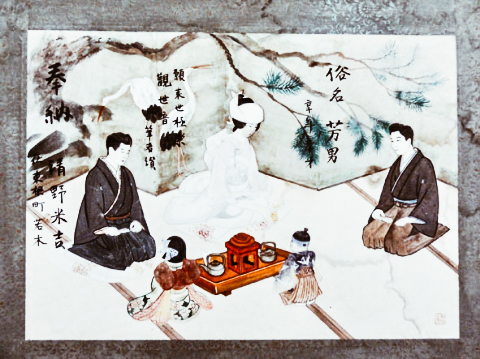
photo credits: hotoke-antiques.com
They differ from normal Ema, because their inscriptions are addressed to the spirit of the child, rather than to kami or buddha. Of course, they express all the anguish, sadness, regret of the mother or sometimes even both parents. The most common inscription, according to Reader, is a simple 'Gomen ne' (ごめんね) or 'I am sorry' ['Forgive me'] together with the reason for the gesture. This phenomenon was particularly striking at the turn of the late Edo and early Meiji periods, when extreme poverty and famine hit the Japanese population hard. The use of Mabiki Ema, however, has continued until contemporary times.
Mukasari Ema, another particular case
.
Another case of a death-related plaque is that of the Mukasari-ema (ムカサリ絵馬). In fact, these tablets were created for a singular purpose: to complete the CDs. Shirei Kekkon (死霊結婚), the marriages between dead souls. They belong to the category of large ema and, according to Robertson, their diffusion seems to be limited to Okinawa and the north-east of Japan, in the Yamagata Prefecture. "Mukasari' would in fact mean 'marriage' in the Yamagata dialect (not coincidentally written in the katakana alphabet). In essence, these Mukasari-ema allow to "simulate" in the representation of the plate, the marriage of a person who died single or unmarried. It is a way of allowing the soul to find peace, preventing it from becoming a tormented spirit.
For if that were to happen, the spirit might remain anchored in the earthly world, through grief, for not having been able to experience the joy of starting a family. Thus, haunting the world of the living. It is thus also a way for the family of the deceased person, however fictitious, to realise that dream. In modern times, one can also resort to photographs, if any, of the person in wedding attire while still alive. Such Mukasari-ema were particularly used at the time of the Second World War, for the reason easily imaginable.
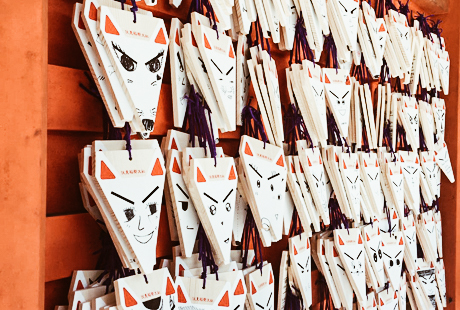
photo credits: journals.openedition.org
These are two borderline cases, the exception to the rule. Because, as is now clear, the Ema are made with an eye to human wellbeing, in the here and now, be it individual or extended to the whole of humanity. But they are still part of the Ema world and, if there is something that they have in common with the others, it is a significant function: the psychological function of releasing an inner burden. The very act of 'unloading' onto the tablets what one has inside - thoughts, desires, needs and concerns - is a profoundly cathartic act. Especially if those desires and needs run counter to the norms imposed by society. As Reader notes, a way for individuals to survive in situations beyond their normal control and the only way to survive, from social control.
People's desires
.
But in general, what specifically do people who have recourse to EMA want? We could identify two macro-areas: protection and success.
Health is certainly one of them, and it is a major theme at all times. As mentioned in the introduction, kami and buddha are associated with healing powers, attributed by extension also to shrines and temples dedicated to them. Requests for 'mercy' from illnesses and diseases - or for preventive protection from any danger - may concern the applicant himself, his family members, or other persons. Requests for success, which is a very popular area, may also concern the applicant or third parties, or a 'collective self' of which the applicant is a part. This is the case of all those requests made to propitiate the success of one's own company or institution of any other nature. There are Ema's for example where the requester is concerned with the success of their favourite team (baseball is very popular in Japan).
But there is one realm that stands out above them all: education. The contemporary Japanese education system is very rigid and competitive, and the pressure of failure on children can be particularly taxing, psychologically speaking. So, you want for that reason alone. Or even for inspiration - seeing friends or groups of peers go to religious centres to write their plaques - the fact remains that students represent a good chunk of the Ema's "clientele". In addition to asking for 'heaven's favour' in the success of tests and examinations, Ema registration can represent a moment of light-heartedness for the very young.
How could we not mention at this point the kami shinto Tenjin (天神), patron of culture and education, certainly popular among Japanese students. (Incidentally, Tenjin is the deification of a person who really existed between the 9th and 10th centuries AD! A Heian court scholar and politician, in life his real name was actually Sugawara no Michizane). His shrines are busiest in the cold months, especially January and early February, when the infamous "entrance exam hell" takes place.
There is no shortage of requests concerning material well-being as well as those concerning affairs of the heart. Even those to "sever ties" with the help of the special Enkiri-ema (縁切り) to express the desire to break the cord that binds to people, things (vices, addictions) or situations (diseases).
The incineration of the tablets
Yes, this is an important stage in the life of the tablets: the final one. Both Shinto shrines and Buddhist temples periodically burn the tablets offered for a dual purpose: ritual but also practical. (In Japanese religiosity, the practical and spiritual dimensions manage to marry serenely). The pragmatic motivation is simply... the need to make space! After all, hundreds and hundreds of tablets accumulate over time.
Spiritual motivation, on the other hand, is that through the ritual of the bonfire, people's wishes and requests can reach the realm of the kami and the buddha. Kami and Buddha who, I remind you, should have already read the Ema, always available in temples/sanctuaries, before the fire rituals. Once again Noragami comes to our aid, with its story so illustrative. It is not unusual to see the Tenjin himself wandering around in the sanctuaries dedicated to him, next to the Ema tablets. Noragami also touches on the theme of severing ties, which we spoke about earlier (in short, you get the hint: watch/read it).
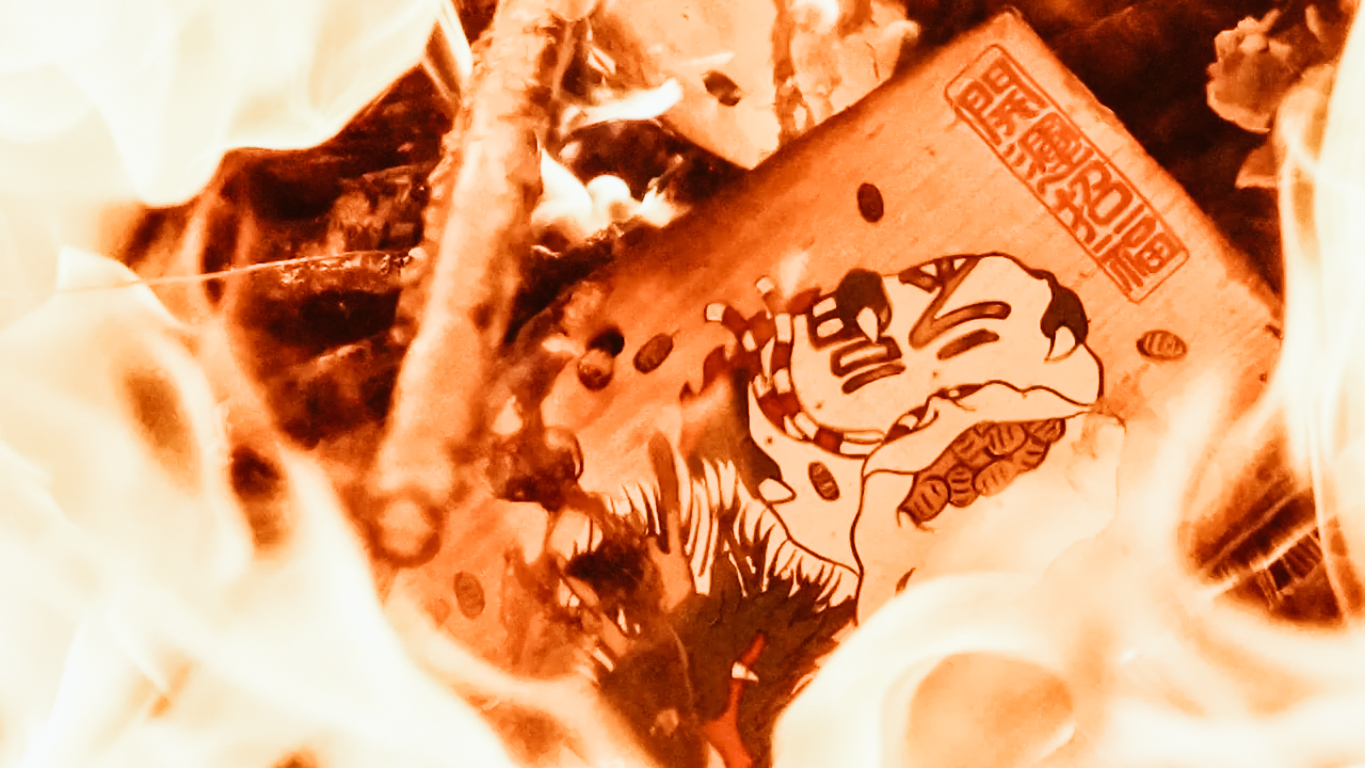
photo credits: https://youtu.be/Vn6AoThrXyc
When does this ritual take place?
The changeover to the new year is the moment that brings everyone together. However, it can also take place at other times, depending on each religious centre. Tenjin shrines, for example, usually do it at the end of October, just after the festivals dedicated to him.
The period around New Year's Eve, O-Shogatsu (お正月), is however ideal for everyone, being a time of transition. What better time to symbolically release what has now had its day, releasing the wishes and demands of the old year? And at the same time, what more propitious time to usher in the new year, perhaps by writing new ones? Boy, so many commissions for these kamis and buddhas from the very first sighs of the new year! The phrase "Getting rid of the old to make room for the new", in this context, can only fit well, lending itself more than perfectly to this dual interpretation.
Nothing rains from the sky!
.
But be careful not to misunderstand. Don't think that this is merely an act of superstition: nothing could be further from the truth! Resorting to the Ema is not the same as thinking of folding one's arms and waiting for an otherworldly grace. Those who resort to the EMA generally know, even with a hypothetical "favour from heaven", that 95% of the chances of success are given by their own commitment. And one's own mental attitude. I refer, of course, to all situations where one has power of action. In cases where this is not possible, the only thing to do is to try to act, as much as you can, on your mental attitude.
Ema tablets testify to the search for change or safety from some risk or danger. They have the power to approach even the most "secular", those who perhaps do not lead a great spiritual life. This may be the case for many young people, or for children, who may see in the tablets a playful side, as well as a support for their studies. The meaning of offering an Ema tablet is basically to cope with a crisis, of whatever nature, by resorting to the supernatural dimension, which has always been a source of support. In other words, the Ema performs a function of comfort and support. And, by extension, an important therapeutic function.
Okinawa and The case of the over centenarians
The Japan Italy Bridge column continues to promote in-depth studies related to the world of Japan, today we are talking about Okinawa and the case of the over one hundred-year-old population.
"At 70 you are only a child. At 80 you are a young man. At 90, if your ancestors call you to heaven, ask them to wait until you are 100 years old. Then you can think about it". So says an ancient saying in Okinawa, unfailingly quoted every time you get ready to talk about its mythical inhabitants. Words that seem to find confirmation, even in ancient legends that would speak of this place as a "Land of the immortals".
Okinawa 沖縄 The case of the over centenarians
Guest Author: Flavia
A few years ago even the show "Le Iene" brought the case of Okinawa to prime time, giving us a very nice report. The longevity of its inhabitants and even more so the incredible quality of their ageing is immediately witnessed by the first two ladies who appear in the tv show. I think that whoever saw them was amazed: I don't lie if I say that they show something like 15 years less! Unbelievable. As noted by the journalist Nadia Toffa, sent by the tv show in question, we also have them here in Italy. So the point is, how do you get to those ages. That is: with what quality of life? Usually, the pains of our elderly people, as we know, are such as to affect the quality of their last journey of life. As a society, it is now accepted that illness and loss of autonomy are what is hopelessly awaiting us when we cross those age thresholds. Well, the case of Okinawa's (super-) grandparents shows us that things don't have to be like that! And that it is in everyone's power to ensure psycho-physical well-being during, starting from ... as soon as possible! The sooner you start to treat yourself, the better you can prepare for your old age.
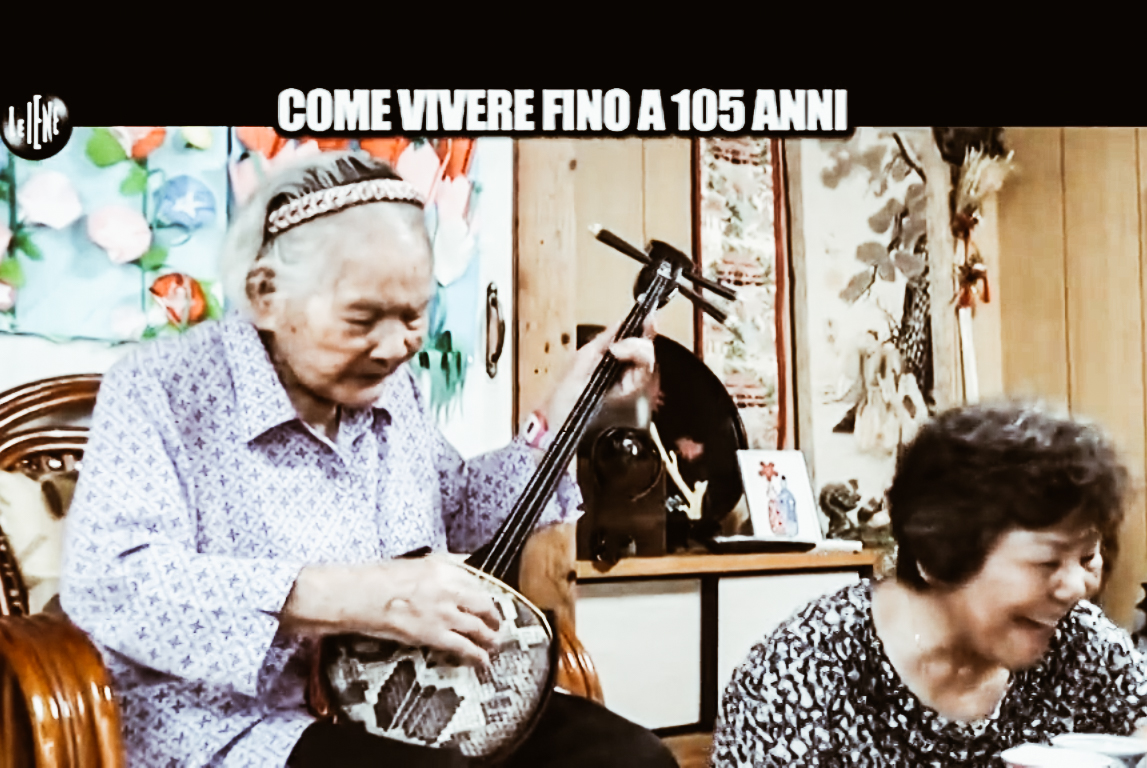
photo credits: mediaset.it
The typical ailments of our western societies - which often even young people(!) like to experience - Okinawa's elders almost don't know what they are. The incidence of diseases related to senility or degenerative diseases such as osteoporosis, Alzheimer's disease, sclerosis, cancer... is very low.
Okinawa: blue zone, paradise of longevity
These people have an extraordinary quality of life own on this island. We are talking about people who have never been to the hospital, who have never taken medication... who are even able to continue working or driving their car beyond the age of 90/95. Who in any case have a margin of autonomy unthinkable for a local elderly person, except in sporadic cases. Among them, the small village of Ōgimi stands out for the high concentration of centenarians compared to the total number of inhabitants. In reality, a case of similar longevity is present, you will know, also in our house: in the nearby Sardinia. Not by chance: Okinawa, Sardinia, the Greek island Ikaria, the Costa Rican Nicoya and a small community near Loma Linda in California, all fall under the name of "blue zone".

photo credits: ilviaggio.biz
Any area in the world where life expectancy is higher than the general average is called the "Blue Zone". Real "paradises of longevity" that attract researchers from all over the world to try to capture the "secret" of their populations. In this sense, Okinawa and its inhabitants even surpass even mainland Japan, which does not lag behind in terms of quality of life, but has a higher incidence of disease, for example.
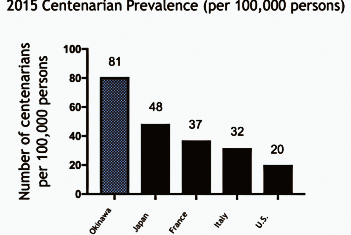 photo credits: orcls.org
photo credits: orcls.org
But who are the Okinawans? Let's first find out who we're dealing with.
Identikit of the Japanese "tropics"
Okinawa is the main complex ( 沖縄諸島 Okinawa-Shotō ) of the Ryūkyū archipelago and is located between "mainland" Japan and Taiwan. It consists of a main island of the same name plus other smaller islands. Naha ( 那覇 ), is its capital. It was named prefecture of Japan in 1879 although the Ryūkyū complex ( 琉球諸島 Ryūkyū -Shotō ), which incorporated it, was formally annexed in 1874. At that time Japan was in the process of modernization and this was matched by a process of unification of all the territories of the archipelago under a single flag.

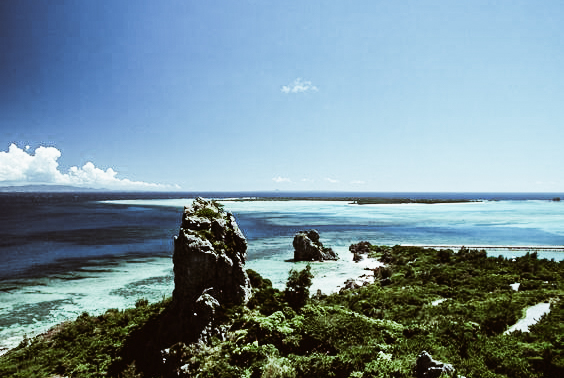
photo credits: lacooltura.com, pinterest.it.
Before 1874 Ryūkyū was an autonomous kingdom, whose foundation in the 15th century led to the unification of the islands of Okinawa. Formally it was recognized by the Tokugawa - lords of Japan until 1868 - under the jurisdiction of the fief of Satsuma (today Kagoshima Prefecture). In fact, however, it was independent, so much so that it was the fiscal kingdom of both Japan Tokugawa and, even before that, China.
Okinawa is a rather peculiar region, more in its own right than the rest of Japan. It is influenced by China and South-East Asia, due to the frequent trade and cultural exchanges maintained by the Ryūkyan Kingdom over the centuries. Okinawa cuisine itself and Karate, the made-in-Okinawa martial art par excellence, are the result of such interactions.
The lush nature of these islands, made up of numerous coral reefs and extensive rainforests, together with a sub-tropical climate, makes Okinawa a true paradise. It is not uncommon to find it referred to under expressions such as "tropical corner" or "Caribbean" of Japan. A climate that is somewhat reminiscent of that of the blue zones of Sardinia and Ikaria, which are also islands. I am not surprised that paradises like these can host "elixirs" of long life.
But let's see what researchers' discoveries tell us about Okinawa's elixir.
The ORCLS researchers' studies
The Okinawa Centenarian Study (OCS), is the longest centenarian study currently in existence. It is conducted by the Okinawa Research Center for Longevity Science (ORCLS) research team, which has been reviewing various aspects of local life since 1975. Among these, social, psychological and spiritual aspects are also given high consideration. Professor Craig Willcox, interviewed in the service by the Hyenas, is one of the leading researchers. Willcox tells the Hyenas' cameras about the discoveries his team has made over the years. First of all, the presence of a particular gene, FOXO3, readily christened the "longevity gene", was observed. However, the researchers found that longevity and longevity quality are inversely proportional to a number of health risk factors that were present before the age of 50. That is, the chances of reaching at least 85 years of age in good health increase if there are no more than 7 risk factors before middle age. Conversely, with more than 7 factors, Willcox tells us that the odds can be as high as 0%.
And here are the risk factors:
- Hyperglycemia (with risk of diabetes)
- Hypertension (with risk of heart attack or stroke)
- Excessive alcohol consumption
- Low level of education (education would foster a greater awareness of what it means to have a healthy lifestyle)
- Being overweight
- Poor diet (lack of vitamins, proteins, mineral salts)
- High triglycerides (with risk, for example, of arteriosclerosis)
- Low gripping force in the hands
- Smoking
- Only for men: don't be married!
The latter is quite curious, as Toffa immediately notes in his interview. Willcox motivates him as follows: "women are much better [at taking care of themselves] they don't need men, they can survive without them". This is why having a woman at your side would increase the life expectancy of the average man. However things may be, if we think that historically Okinawa women play a key role in Okinawa society, this could take on a wider meaning. And good Okinawan women!
Not only Okinawa DNA
But the research does not end there. Willcox says he and his team examined a sample of 8000 men with Japanese ancestors in their genealogy. Considering the two analysis variables, presence of the FOXO3 gene (1) and healthy lifestyle (2), they divided the subjects into 4 groups. Well: the individuals who possess the gene linked to longevity, however, have an incorrect diet, live less than those who, although not genetically predisposed, maintain a healthy diet. This clearly shows us - as Willcox says - the power that a healthy diet and lifestyle have on the physical health of individuals.

photo credits: mediaset.it
Another thing observed is that the Okinawan population does not consume more than 1100 calories per day. This is 10% less than the calories usually indicated by each nutritional table. In particular, their habit of "nibbling rather than bingeing," Willcox always explains, "is key. But a snack made from healthy food: snacks, for example, are made from dried fruit or dried fish (a snack that is also common in mainland Japan). All this in conjunction with a broader, healthier lifestyle.
Shall we find out in detail what all this consists of? Let's start with eating habits.
#1 Traditional diet
Two, are basically the principles underlying the Okinawan diet and concern quantity and quality of food.
腹八分 (Hara-Hachi-Bu): " stomach [full] for 8 parts"
That's 8 parts out of 10: "Always leave some space in your stomach...that is, eat until you are 70-80% full" explains Willcox. A guideline, it would seem, of Confucian origin, which seeks moderation rather than satiety: never fill up completely but eat what is strictly necessary. And in fact, the second elder tells journalist Toffa: "I eat what is right but never fill myself completely. I always get up with a bit of hunger".
The Okinawans are used to eat 5 meals a day (which is also recommended by local doctors), opting for low-calorie but satiating foods. Let's keep in mind the setting of the table, which is typical of Japanese cuisine. The contemporaneity of the dishes, through their arrangement in saucers and bowls, is a factor that certainly predisposes more to "small tastings" than to binge.

photo credits: travelbook.co.jp
I-Shoku-Dō-Gen ( 医食同源 ), "food and medicine, same origin", from Okinawa
For the local elderly, there is nothing healthier than lovingly caring for the garden and then feeding on the fruits of the earth. If we add marine food to these, we have our own miracle diet. This is what it is made up of:
- Greens. Especially with green leaves, yellow roots and orange roots, all containing carotenoids and anti-inflammatory agents.
- Tubers like the sweet purple potato of Chinese origin, with a very low glycemic index. Eugenio Iorio, an Italian researcher, explains: "it is there [in the purple] that these famous polyphenols [...] dialogue with our DNA and therefore help us to control the effect of free radicals";
- Legumes. Like soya beans (with protein and fibre but without fat) and soya derivatives;
- Algae, natural anti-inflammatory, ideal for free radicals and also for hair;
- Fish and the already mentioned dried fish, rich in magnesium and omega 3;
- Tea. Especially green tea and jasmine tea, anti-ageing;
- Herbs to chew like Sakuna, "herb-elixir" slimming and antioxidant;
- Fruits. Among which bitter melon Goya, used in the typical dish "Goya Champuru" and citrus Shikuwasa, anti-inflammatory, both typical of the place.
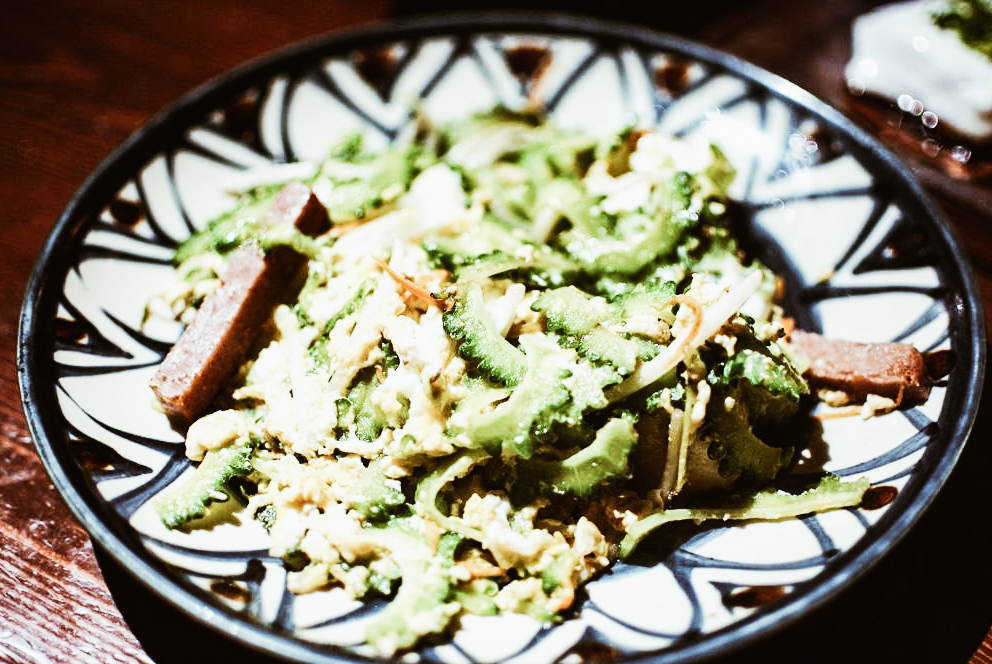

photo credits: ohayo.it
"Eating like a rainbow"
In the words of Dr Willcox, by virtue of the parade of colours that the great variety of fruit and vegetables brings to the tables of Okinawa. Variety. Another watchword in the agenda of the Okinawans who would use at least 18 foods daily. The important thing, however, is always to respect the seasonality of the fruit and vegetables. In this way, the maximum nutritional potential of the fruit and vegetables can be realised. And of course, the freshness of the food. It is also important if you decide to cook them, especially when it comes to fish and vegetables: never overcook them if you want to preserve the nutrients!
In addition to very low consumption of carbohydrates, salt and sugar are also used very little. Yes to spices, such as turmeric, and mushrooms.
What about meat?
As a result of that Chinese influence mentioned at the beginning, meat consumption is also well established in Okinawa's cuisine. But meat, as well as dairy products and cereals, are categories with a high nutritional density...so they are consumed in even smaller quantities! Even rice is eaten less than the rest of Japan and quinoa is often preferred to rice. We speak of a low-calorie diet also for this reason; because it counterbalances with smaller quantities of nutritional contributions otherwise potentially excessive. Also because vegetable and marine foods and fruit remain the true carriers of all those beneficial substances that make up the food elixir of Okinawa.
#2 Motor and mental activity
"When the body moves, the brain goes into rhythm" - this is the motto of Jim Kwik, an internationally renowned trainer who deals with fast learning. Kwik always urges even those who have to spend their days sitting down for work or study not to stay in the chair all the time but to take breaks and move around. Even just a few minutes of simple movements between breaks, as well as drinking water and making small snacks, are enough. In doing so, Kwik suggests, our performance is even better, because the brain works better if we treat ourselves this way. Exercise as a stimulator of neurogenesis and neuroplasticity: facilitates the creation of new neural connections. In short, physical movement is also a gym for the brain! That comes out strengthened. And if the brain is active the whole organism benefits. It is a vicious, beneficial circle that, when activated, becomes self-feeding. And this is also the basis for all the nutritional discourse that has just been made, as well as the other factors that we will see in a moment. Let us bear in mind that this discourse is not compartmentalised: everything is connected.
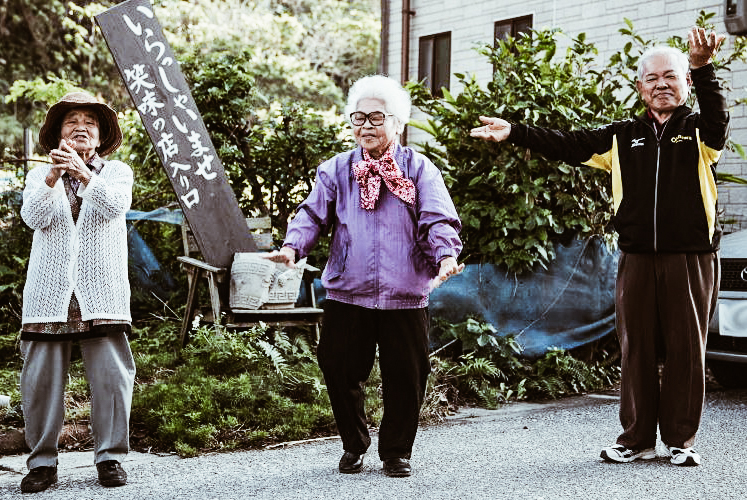
photo credits: okinawa.stripes.com
Observing the lives of our Okinawans, we find that, in their own way, they put into practice very similar things to those promoted by Mr. Kwik. The second reason for their well-being lies in the fact that they are active, not only in their body but also in their mind! The grandfather we see in the hyena service, for example, reads the newspaper every day when he returns from his morning walk. And watch out, 100 years go by, he does so without the help of glasses. Not to mention the fact that he worked in the countryside until he was 97 years old!

photo credits: mediaset.it
Among the activities most loved by Okinawa's grandparents - in addition to the garden, as already mentioned - we find traditional dance or dabbling with some traditional musical instrument. Or, martial arts, ideal for the body-mind-spirit system, as in the case of master Seikichi Uehara. Uehara, a few years before his death at the age of 100, still taught Karate to his students. Or again: how not to mention the weaver Toshiko Taira who, at the age of 100, continues to work as a weaver of Bashōfu, an ancient fabric used for the Kimono (produced only at Ōgimi).
#3 Interior and exterior attitude
But it's not just a question of genes and nutrition. Turn that turns you back, you always come back there: the mind (and the spirit, which in the Japanese vision is one with the mind - as the parola心 "Kokoro" or heart/mind) testifies. Once again, the vision of things proves to be decisive. The most cynical ones will be tired of always hearing "the same old tune", I know; but instead of automatically throwing it on scepticism, I would start to give more credit to the "power of the mind". There will be a reason for this if it is invoked from many quarters. Those who have somehow experienced the beneficial influences of a clean mindset, from excessively... interpretative distortions of reality, let's put it this way.
The perception of the world and therefore of oneself has the power to affect the tangible world of people. Let's think about psychosomatic illnesses for example...or even just inner dialogue: thoughts or words directed towards something can influence this something, including ourselves.
Thus, even Okinawan scholars recognise optimism as a not inconsiderable factor, as well as more tangible factors. Optimism, attention, understood not as pretending that the challenges in life do not exist...but as a different way of accepting both the good and the bad. An openness towards life, which avoids complaining and the negative vision of things. A serenity given by knowing one's own soul and place in the world, with a consequent trust in life and in others. From giving the benefit of the possibility, to everything and everyone.

photo credits: mediaset.it
#4 Interpersonal relationships and social life
When this happens, the mind/spirit "machine" works properly and you feel better at 360 degrees. Even in the seemingly obvious little things that have their own importance, such as simple but authentic moments of conviviality. People in Okinawa generally have a very healthy social life, based on trust and balanced communication. It is often overlooked, precisely because it may seem like "the usual rhetoric", but, believe me, communication is essential to maintain healthy and satisfying human relationships. When people manage to have sincere, spontaneous, and serene communication - without any quarrels of any kind - the relationships are perfectly balanced. Without balanced and satisfying human relationships, the life of a human being is not the same. Just as moments of healthy solitude are essential, to rebalance oneself and recover one's energies, so, at a certain point, are human relationships. But be careful: they must be healthy and balanced. Just like those of our Okinawans.
The deep sense of belonging to the community that characterises their network of relationships and the value attributed to the elderly creates a buffer effect on the elderly that gives them confidence. With a community ready to support them, grandparents can thus live freely and still feel useful. Would you have me believe that the love and trust surrounding these people do not contribute to their quality of life?
#5 Spirituality
And all this takes us towards the last factor that remains for us to consider: spirituality. It "ferries us" because an approach to life like the one we have seen, from that part of the world, goes hand in hand with a certain kind of spiritual sensitivity. These two things are intimately linked if we think about it, and it could not be otherwise.
The philosophy of finding one's own reason to live, what gives it meaning, is from Okinawa, the famous Ikigai ( 生き甲斐 ). If this is missing, there is no healthy diet or strong genes to keep, for a long and quality life. Even the saying "Nan kuru nai sa ( なんくるないさ )" that is "Don't worry [it's all right] " is made in Okinawa. It indicates the profound belief that everything that happens in life has its own intrinsic meaning and that it serves us, for our growth. Having said that, everyone can and should do everything in his or her power in the situations that life confronts him or her with. If this is done, then the motto says to us "you have nothing to fear: everything you could do you have done, so it is all right, be at peace. Everything is as it should be".
Prayer and meditation, also beneficial against stress, are very present in the life of the Okinawans. In the morning, for example, they gather in front of an altar traditionally present in their homes to commemorate and thank their ancestors. This aspect of thanksgiving is something very important that potentially has an impact on the mentality and one's own worldview. And the same care of the vegetable garden already invoked higher up or even eating calmly (devoting all the attention to the act itself, without dispersing it with the TV, for example), is in truth in itself, already meditation.
Nature and environment
A spirituality in any case always close to nature...that recognizes the soul. Could it be that it is precisely the sharing with nature that has inspired these people over time to the right behaviour for a beneficial lifestyle? Although this specific aspect is difficult to quantify with empirical data, I believe so. Also because, if we take for granted that mentality and worldview can have power over our lives... why then discard a priori the power of the "spirit of nature"? Just like animals (think of pet-therapy), so can nature.
The spiritual is very present all over Japan but in Okinawa, it can count on a more uncontaminated nature, at least, compared to other places in the world. Let's remember that the increase in free radicals - potentially responsible for cancer - is also favoured by pollution as well as by bad behaviour. In order to link up with what we said at the beginning when we were thinking about the other blue areas, even the environmental factor - the ecosystem - has its own weight.
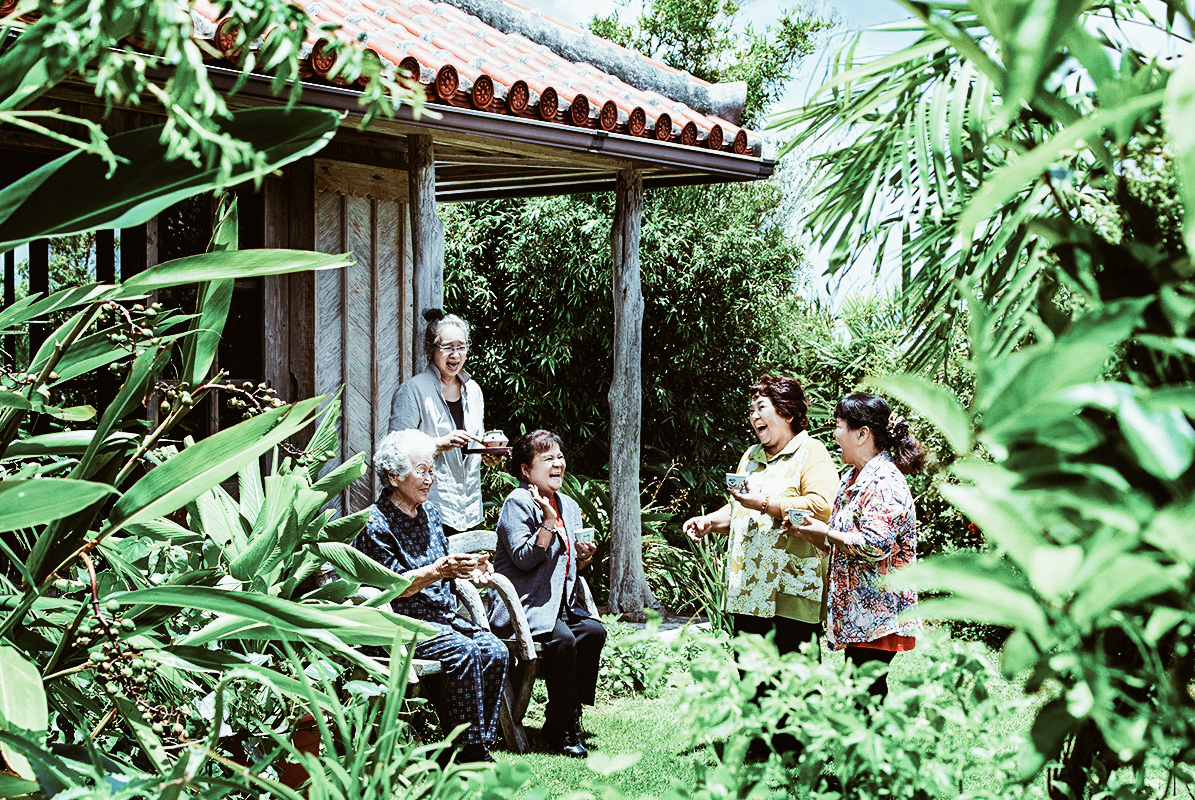
photo credits: visitokinawa.jp
The power of the Okinawa lifestyle
And so, alongside: healthy and balanced nutrition; the balanced activity of body and brain; a good relationship with life and consequently with others, here we have the spiritual dimension. But again, there is no hierarchy between these factors: just like the courses of the Japanese tables, they are all contemporary. Each one depends on the other and each influences the other. Of course, you will say, there is always a genetic predisposition. But while genes are not chosen, all these factors are in the hands of individuals. They are in their power. Good genes are undoubtedly a plus. However, as widely observed in OCS research, an individual with a healthy lifestyle lives better and for a long time, even without such a gene. While its effectiveness can also be cancelled out by the lack of just one of the other factors. This is already being demonstrated by the new generations of Okinawa. In fact, the young people of the area are at risk of losing the health benefits of their grandparents by becoming westernized between sedentariness and technology, consumption of pre-packaged food full of colourings.
Even in Italy, it is possible to have the same nutritional benefits as the Okinawa diet. After all, our Mediterranean diet, as Eugenio Iorio also tells us, is based on the same principles. Therefore, we also have the same food supplies in our lands and in our sea. We also talk about "MediterrAsian diet" if we try to integrate the two nutritional models. On the other hand, the Okinawa lifestyle and the Sardinian and Ikarian styles have some aspects in common: high consumption of vegetables and legumes, active and especially outdoor life, and finally, social life and strong family ties.
Fuji san, a deep focus on the symbol of Japan
Snow-capped peaks, dizzying slopes, harmonious and perfect shape: Mount Fuji. Breathtakingly majestic, a famous cultural icon: a mystical and spiritual place. There are no words to describe what it feels like to be in front of this wonder of nature. Its importance is such that it is often said that, more than a symbol of Japan, it is Japan.
Mount Fuji 富士山 The symbol of Japan
Guest Author: Flavia
Fuji (富士山 Fu-Ji-San) is located in the Chūbu region (中部地方), about 100 km southwest of the capital Tokyo. It lies between the current prefectures of Yamanashi and Shizuoka, with Kanagawa prefecture to the east. The entire area is part of the Fuji-Hakone-Izu National Park (富士-箱根-伊豆-国立公園Fuji-Hakone-Izu Kokuritsu-Koen). Together with Mount Tate (立山) and Mount Haku (白山) is part of the CDs. Three Sacred Mountains ( 三霊山 San-Rei-Zan ) so identified because they are sacred to the Japanese tradition.
The numerous cultural-historical sites around the mountain testify to the great spiritual significance that has always been attributed to it. In pre-modern times it was, in fact, a pilgrimage destination for monks engaged in spiritual research and self-discipline, as well as for ordinary people.
Today this religious connotation has been lost. Although the idea is still widespread that climbing to the top of Fuji at least once in a lifetime is almost a religious duty. Nowadays, climbing is also facilitated by modern means, thanks to which the route to be made on foot is more than halved!
Source of inspiration for a vast cultural production (literature, poetry, art...), its influence has reached the West. It is now well known how much the prints of the masters Hokusai and Hiroshige, portraying Fuji, influenced Monet and Van Gogh.
The fact that it appears among the yen bills and in the name of the main television station is indicative of the central role it plays for the people of the Rising Sun. So much so that it is classified as a "Special Site of Scenic Beauty" and protected as cultural property by the Agency for Cultural Affairs (branch of MEXT). In 2013 it is declared World Cultural Heritage by UNESCO. It is included in the category culture - rather than nature - because its impact goes far beyond its natural essence. There are at least twenty-five sites of interest recognized by UNESCO, on Japan's most important mountain.
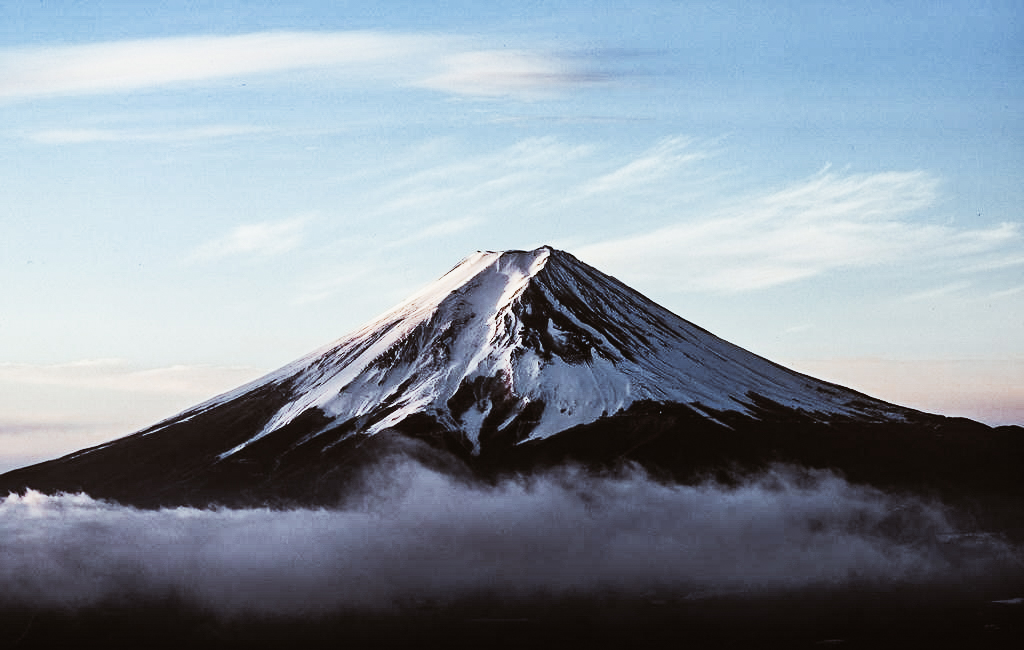
photo credits: expedia.it
Fuji Geological History
Fuji is classified as a stratovolcano, a volcano formed by the accumulation of layers of solidified lava and volcanic ash. Its particularly steep slopes, its perfect conical and symmetrical shape are the results of this overlapping process. It has a crater with a diameter of about 600 meters, 250 meters deep, and at least 70 small secondary peaks including Mount Hōei and Omuro. Its volcanic activity began more than 100,000 years ago.
It was long agreed that there were three stages of the stratification process, called "Small Peak" (小御岳Ko-Mitake), Old Fuji (古富士Ko-Fuji ) and New Fuji (新富士Shin-Fuji). Since 2004 new studies and explorations have revealed the existence of a fourth phase Proto-Komitake (小御岳 Sen-Komitake). It is currently believed that the Komitake originated as a result of eruptions produced by the Proto-Komitake hundreds of thousands of years ago. Just as about 100,000 years ago an eruption of the Komitake gave rise to Old Fuji, the summit of which reached about 2,700 meters with subsequent eruptions. So the Fuji over the millennia has been gradually shaping itself. It reached its present form about 10,000 years ago, after Old Fuji and Komitake also disappeared under the layers of lava.
It erupted nine times between 781 and 1083, and then it remained quiet for a few centuries. Its last eruption - which formed Mount Hōei - dates back to 1707, which for a while led to classify it as dormant. But around 1960 there is a change of definition: it is defined as "active" every volcano whose eruption has ever been documented. In 2003 a further update extends the definition to every volcano that has ever erupted in the last 10,000 years and that continues to give signs of activity. Under these last two designations, Fuji is now considered active. It ranks at 5 in the Volcanic Explosivity Index on a scale from 0 to 8 (like our Vesuvius and Etna).
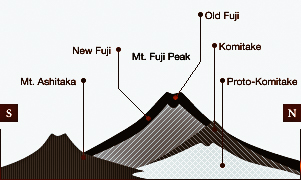
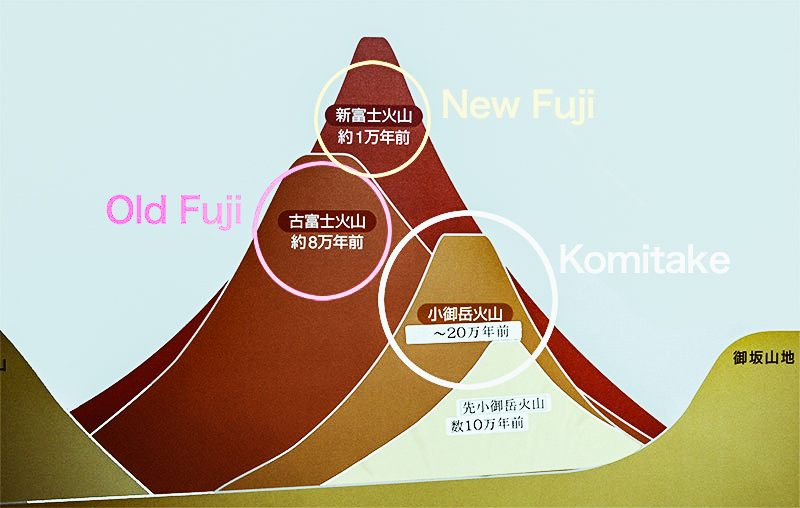
photo credits: web.archive.org
Geography and territory of Fuji San
Thanks to its 3,776 meters of height, our Fuji is undisputed as the highest peak in Japan. However, between 1895 and 1945 it was climbed by another mountain! How? Because of the post-war agreements closing the first Sino-Japanese conflict, with the Treaty of Shimonoseki, when Taiwan came under Japanese control. Therefore, formally, in those years Taiwanese territory was Japanese. Thus, the Taiwanese "Jade Mountain" (玉山 Yu-Shan) - then called by the Japanese "New High Mountain" (新高山Nii-Taka-Yama) - with its 3,952 meters manages for 50 years to overtake Fuji-San.
There are three towns on its slopes (whose names also characterize three of the main access routes to Fuji): Gotemba (御殿場) to the east, Fujinomiya (富士宮) to the south-west, Fujiyoshida (富士吉田) to the north.
Five, the lakes (富士五湖 Fu-Ji-Go-Ko) that surround it: Yamanaka (山中湖); Kawaguchi (河口湖); Saiko (西湖); Shōji ( 精進湖 ); Motosu (本栖湖). Curiosity: the latter in particular would be the Japanese version of Loch Ness. Legend has it that in 1970 they sighted a creature of 30 meters with rough skin and full of humps: it was promptly christened Mossie!
Near the lakes, to the north-west, we also find a forest of 3000 hectares: Aokigahara (青木ヶ原), also known as Jukai (樹海) or "sea of trees" (sadly known for the primacy of suicides, second only to the Golden Gate Bridge in San Francisco). The area is also rich in caves and hot springs.
Mishotai (御正体山) and Shakushiyama (杓子山) in the northeast, Kurodake (黒岳) in the north and Kenashi (毛無山) in the west, are the closest peaks from which you can see Fuji in the front row.

photo credits: itinari.com
Fuji, etymology and meanings: But what does "Fuji" mean?
The first thing to note: the name "Fuji" already existed before the introduction of Chinese ideograms or sinograms. The characters used to indicate it were therefore chosen according to their pronunciation so that the latter would coincide with the pre-existing pronunciation. Written as it is today, i.e. 富士山 (Fuji-San), it is given the meaning of "Prosperous Mountain".
There are, however, different opinions that in the past "Fuji" meant something else. Everything always depends on the writing: the same pronunciation can correspond to more than one meaning. Ergo more words, distinguishable at that point from the writing (as well as the context).
Here are the most popular theories about the meaning of Fuji:
- Unparalleled Mountain【不二山】: very popular is the theory that the name of the volcano was originally written with these Kanji-ideograms- to mean "Unrivaled Mountain" (二 is the number two, so "not two").
- Monte dell'immortalità【不死山】: This interpretation is based on three works of the past: the ancient Chinese chronicles "Shiki" (史記), the Taketori Monogatari (竹取物語) and the Fuji Sanki (富士山記). The first reports the existence of an elixir of immortality on top of the volcano; the third describes the mountain as the home of immortal beings. The fire of Fuji so metaphor of the inexhaustible "fire" of life. The Taketori Monogatari suggests another etymology, however, that of "mountain rich in warriors" (富 = abundance, 士 = warrior).
- Winterless Mountain【不尽山】: Many people bring back such "inexhaustible being" to the snow because the summit is almost perpetually covered with snow.
These are still theories but, I must say, this last interpretation would be quite precise. Personally I do not disdain even the alternative of the "Mountain without equal", it is certainly right!
The misunderstanding "Fujiyama"
Speaking of Fuji names, it seems necessary to open a parenthesis on the issue "Fujiyama". If only for those who do not know the language. Since it has escaped the pen of its first transcriber, you might also come across this term in some tourist guides. Well, this is a linguistic misunderstanding! An error dating back to the first transcriptions from Japanese to Western languages.
The character 山, which indicates the mountain, is pronounceable with the Chinese reading "san" but also with the Japanese reading "yama". The Chinese reading (on'yomi) is clearly due to the fact that the ideograms come from China. The reading of Chinese origin is mostly taken when you have compound words, otherwise, the Japanese one (kun'yomi) is used. The exceptions are not rare, but Fuji is not among them.
That's why using "Fujiyama" as a translation of "Mount Fuji" (富士山) is an error. 山 " 山 " alone can be read "yama", but next to the name "Fuji" takes the pronunciation "san". Therefore, "Fuji-San" is the only correct pronunciation for 富士山 [Mount Fuji].
If ever, the form "Fuji no Yama" (富士の山 "Fuji mountain") would be admissible since 山 and 富士 are divided by the specification particle の. Actually there is also this expression, but it is obsolete, found in ancient literary works. Some also recognize the possible contraction of this rare term from "Fuji no Yama" to "Fuji-Yama". Even if it was, the eventual absence of the particle の assumes the presence, however, as much as it is understood. This is not the case in the wrong transcription "Fujiyama", where nothing is contemplated between "Fuji" and "Yama". Then, the latter is always an error.
Other courtly or disused versions are:
- Fu-Gaku (富岳 "Abundant Top");
- Fuji no Takane (富士の高嶺 "High peak of Fuji");
- Fuyō-Hō (芙蓉峰 "Lotus Summit").
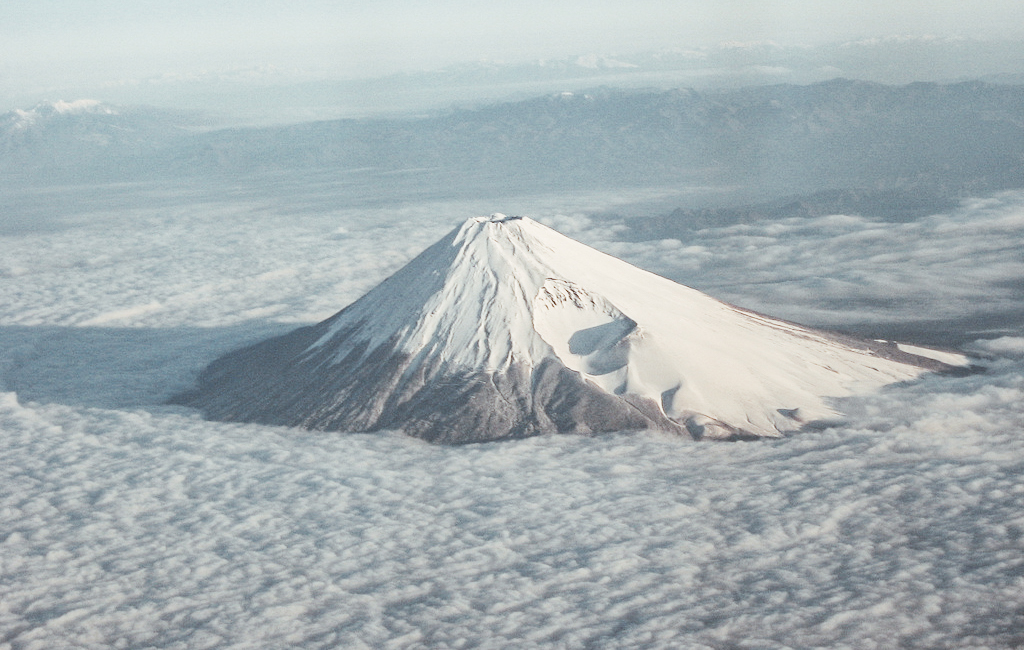
photo credits: kyuhoshi.com
The sacredness of the mountains in the Japanese tradition
Mountains and volcanoes have always had a special place in Japanese spirituality, which has given them a special meaning since the beginning. They are seen as mysterious places, home to spirits as good as bad. A mountain or a volcano is definitely a special, sacred place. A deity, or the seat of one or more gods, perceived by the people as the protector of the whole community.
This autochthonous sensibility - pre-existing to Buddhism - was a form of shamanism that resulted in those beliefs and practices that constitute Shintoism. Shintō made nature an object of worship as an earthly manifestation of the Kami (神 Divinity). Not only the mountains but also the rocks, trees, rivers and waterfalls, lakes...all are perceived as the earthly expression of the Kami. Fuji for example is also defined in Shintō as "Yama no Kami" (山の神).
This Shintō practice of mountain veneration is part of the Kannabi Shinkō (神奈備信仰 "Kannabi Faith"). Kannabi" are all those sacred places used to celebrate and give thanks to the Kami; in the case of mountains, the gods or spirits of the mountain.
This autochthonous conception is then intertwined with the Buddhist vision of the mountain as an ascetic place for the search for enlightenment and the realization of Buddhism; the Taoist one, of the mountain as a mystical place, of Yin-Yang harmony and the five elements; the Confucian one, of the mountain as a cosmic place that connects all living beings in the common search for harmony and self-realization (not in a selfish sense, of course).
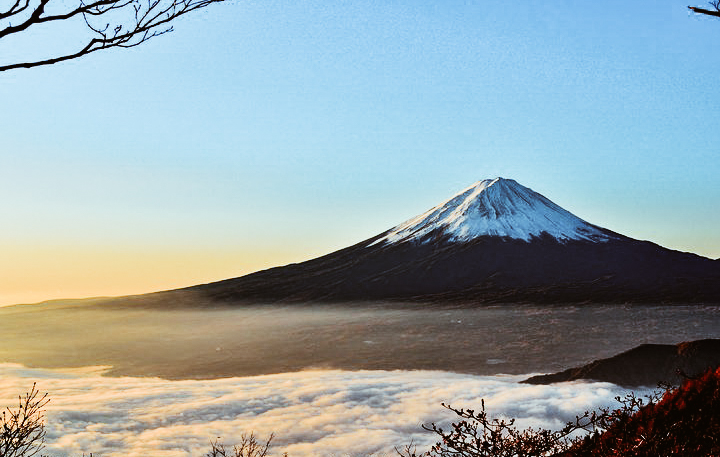
photo credits: tripadvisor.com
The ancient faith Fuji: why worship a mountain?
The question is very simple but full of meaning. The Japanese have always looked at Fuji - at nature in general - with the eyes of a child, I dare say. With attention to its behaviour, reacting and adapting their actions accordingly. To begin with, and before anything else, this "looking", alone, is distinctive of the type of approach that distinguishes these people. Then comes into play as they have observed, that is, with attention. Which brings us to step three: their response after what they have caught. An answer as pertinent as the initial, careful, observation. An answer that communicates nothing else but the acknowledgement "I have recognized you, I have recognized your existence; I respect your will". Only a careful perception could lead to this kind of response.
So think of Fuji, so imposing, so perfect...and so explosive in ancient times: the ancient Japanese could only be impressed by such a manifestation. The first settlements of which there are traces are very ancient: they date back to a period between 11,000 and 13,000 years ago, called Jōmon Incipiente (very first Japanese prehistoric era). Well, among other things, stones have been found, whose arrangement indicated unequivocal ceremonial signs!
Its power, together with its grandeur, led the ancient Japanese to fear it and admire it at the same time. They came to the conclusion that that volcano so powerful had to be the expression of a deity or just a deity (神Kami). For obvious reasons, they tended to consider it a deity of fire. So the Fuji began to be worshipped with the intent to avert its eruptions, inevitably interpreted as the wrath of the deity present there.
The nature of this ancient autochthonous faith remains, in any case, a little mysterious, but it should not be surprising. After all, we are talking about really ancient times.
Fire and Water: the dualism of Fuji-Kami
.
One thing, however, that can be seen with more confidence is that double attitude/reaction of admiration and fear on the part of the ancient Japanese. Despite its smoky character - pass me the term - of the time, Fuji was not perceived as a mere intractable or evil divinity. It was simply what it was. And the Japanese ancestors also considered its positive aspects...almost all of them converging in a single word: water.
In ancient times the water of Fuji has in fact represented an important source of sustenance for the inhabitants of the surrounding areas as well as for the fauna and flora. Suffice it to say that the abundance of water - and food - was considered a valid reason to want to continue living near the volcano, despite the danger it represented.
Even today the abundant rainfall and snowfall that is poured every year are decisive for the maintenance or formation of rivers and springs underground. And even today the water of the mountains - and the mountains themselves - are seen as a source of fertility (think of rice crops). Moreover, the water of Fuji was also considered sacred, so much so that it was later used for ablutions and purifications for religious/spiritual purposes.
Fuji was therefore seen in a twofold way as fire and water-vulcano and spring, divinity of fire and at the same time source of purification. Fear and respect for the power of the volcano: simply two sides of the same coin. Duality, in truth, is a characteristic of this people (it is found in history, in language...). Apparently, not even Fuji is exempt from it!
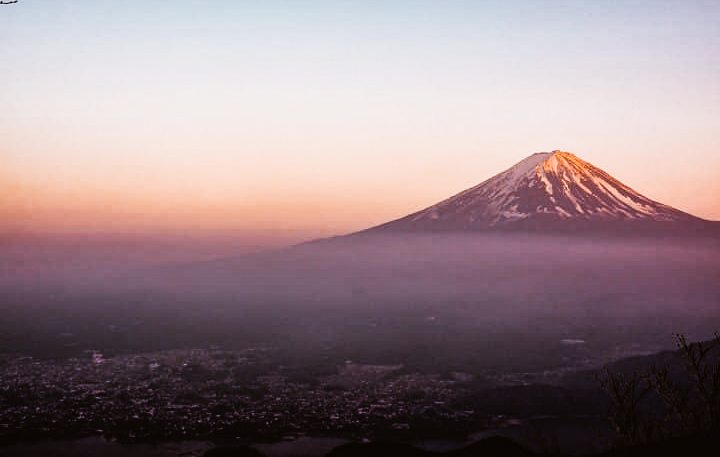
photo credits: matcha-jp.com
Sengen-Asama Sanctuaries
The wrath of the divine-Fuji was very frequent between the end of the 8th and mid-10th century. Thus, around the ninth century, the sanctuaries dedicated to it began to sprout like mushrooms, not only on the slopes of the volcano, but throughout the archipelago. We talk about Asama or Sengen (浅間) sanctuaries when it comes to the god of Fuji (浅間の大神Asama/Sengen no Ōkami). The terms Asama and Sengen are only two different readings of the same word. However, while "Asama" can also be found in other mountains, "theengen" ends up identifying all the Fuji sanctuaries of worship, particularly those on its slopes.
It is often read that the Kojiki (古事記) - "Tales of ancient events" - associates the divinity of Fuji to the figure of the goddess Kono Hana Sakuya Hime (木花咲耶姫). According to the myth, the goddess "Princess who makes the trees bloom" is said to descend directly from Izanami and Izanagi, the original creator gods of the Japanese archipelago. While it is true that the oldest Japanese narrative collection narrates about Sakuya-Hime and her father, the god Oyamatsumi (大山津見神 "mountain goddess"), the association to Fuji is not so obvious. In fact, the historian Byron Earhart - among the main sources of this article - warns that this link is actually recent. And that the Kojiki, in fact, would not make any direct connection between Fuji and the goddess.
In any case, it is in such Sengen sanctuaries that those rituals to prevent catastrophes caused by the volcanic god Sengen-Asama take place. In order to calm his anger, he is even given the title of Myōujin (明神 "Illustrious Kami") or "Illustrious Gods". The rituals consisted of rites of pacification and thanksgiving, accompanied by the reading of Buddhist sutras.
In this phase of the cult, however, Fuji is not yet climbed but rather venerated from afar. This is certainly due to the fact that around the 11th century its volcanic activity was still unstable. It is only with the inclusion of Esoteric Buddhism in this framework - and with the end of the eruptions - that religious pilgrimages will begin.

photo credits: livingnomads.com
Shugendō: where Shintō meets Buddhism
You can't talk about Fuji without talking about Shugendō. It is in fact this practice that significantly increases the popularity of Fuji through asceticism. Shugendō (修験道 "Via della Pratica Ascetica") is the encounter between Shintō tradition and Esoteric Buddhism. A hybrid between native shamanic practices and Buddhist rituality. This "hybridization" consists as much in a mix of elements of each tradition as in a coexistence of the same (some Shintō elements, for example, remain well intact).
The Shugendō takes shape towards the end of the Heian period (794-1185) but the "mountain" Buddhism of the Saichō and Kūkai ascetics of the Nara period is its precursor. As we know, around 1083 Fuji ceased its intense activity. Since then it began to be identified as a place of "apparition of the Buddhas": a place for all those seeking a spiritual path. This path is also understood in the true sense of the word, as witnessed by the spiritual pilgrimages that are becoming more and more a "phenomenon". The practitioners, mainly known as Yamabushi (山伏) or Shugenja (修験者), included different types of ascetics in addition to actual monks.
Its origins can be traced back to the semi-legendary figures of Prince Shōtoku (who would have inspired the above mentioned Saichō) and the mystic-ascetic En no Gyōja or En no Ozunu. Legend has it that both the prince and Ozunu reached Fuji in flight - just in Taoist magician style (仙人 Sen-nin). En no Ozunu is remembered as the legendary founder of Shugendō, the one who would bring rituals and ascetic practices to the mountains.
Shugendō is key because he elaborated and developed the mountain practice born in the Nara era, bringing it to Fuji. And making the latter popular as a place of spiritual asceticism. A fundamental element that characterizes it are the ascetic experiences of its main exponents and the insights they receive from it, determining the syncretization between Kami shintō and Buddhist divinities.
Murayama Shugendō, Matsudai and Raison
If En no Gyōja is the "legendary" founder of Shugendō, more historical are instead Matsudai (end Heian) and Raison (presumably end Kamakura). The two ascetics, which constitute the Shugendō linked to Fuji.
Matsudai, the "Saint of Fuji" (富士上人 Fuji Shōnin) - according to the chronicles the first to climb the mountain - is the one who inaugurated it as a place for ascetic practices. In 1149 he would in fact erected on its summit a first form of a temple dedicated to Dainichi Nyorai (大日如来 the "Great Sun-Buddha"). Thus operating a first syncretism between the divinity of Esoteric Buddhism and Sengen-Asama Ōkami. However, since, then as now, the conditions up there are impervious almost all year round, Matsudai places the base of the neo-movement on the slopes of the mountain. Precisely, in the village of Murayama (today's Fujinomiya)- hence the name "Murayama Shugendō". A complex of temples begins to rise all around the mountain. Since then, Murayama Shugendō becomes a movement of such magnitude that it exerts full control over the mountain (even collecting "tolls" for access to the summit).
But if Matsudai is the forerunner, it is the monk Raison who gives the movement a truly organized structure. Through the network of temples, religious practices and paths - "inaugurated" under Murayama -, Fuji becomes institutionalized.
It is said that Matsudai gives the movement the vertical structure while Raison the horizontal one. Raison opens the ascetic practice on the mountain also to ordinary people, establishing contacts with the so-called lay ascetics (行人 Gyōnin) and leaders of local groups. This already marks a small difference from Matsudai, at that time the movement was more linked to the court and the imperial family (and later to the feudal dominated class).
Raison's work is thus a forerunner to subsequent mass pilgrimages, but it also carries within itself the seed of the decline of the movement. Accomplice the advent of the Sengoku era, with the increase of flows towards the mountain, at a certain point Murayama Shugendō will no longer be able to control all the routes. The killing of the daimyō of Suruga, on which the movement rested, will be the final blow that will mark the sunset of Murayama.
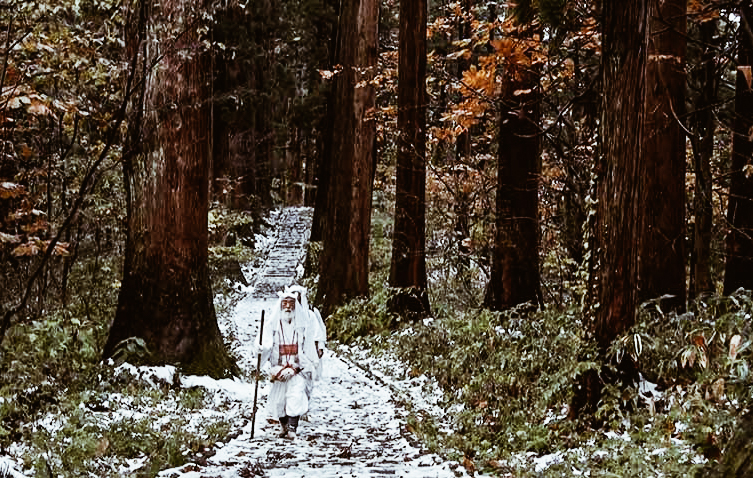
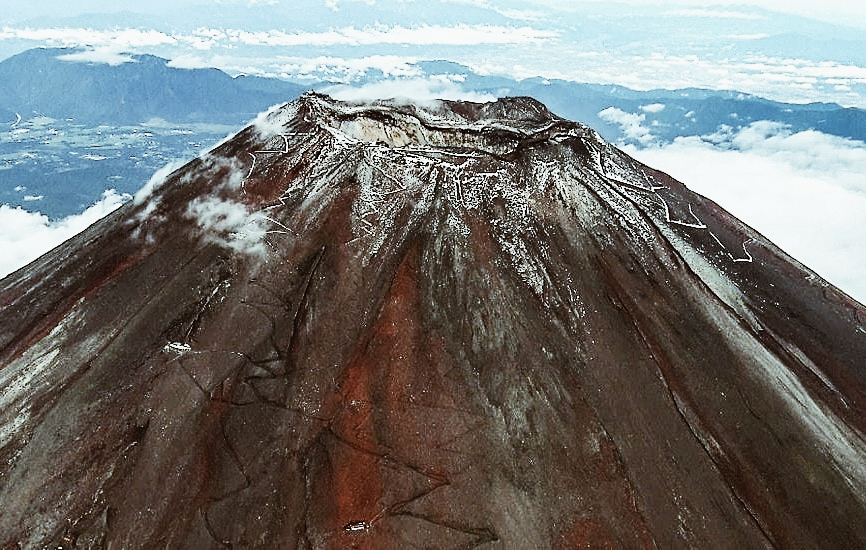
photo credits: yamabushido.jp, mundo-nipo.com
Fuji-Ko ( 富士講 ), Kakugyō and Miroku
It is, therefore, the interweaving with politics and the ruling classes that drags down the Murayama Shugendō. Also because, the new times required new responses to the new historical paradigms that were occurring. We are in the Sengoku era (戦国), the hard era of the Warring States: an era marked by hunger, general disorder and terrible battles, where nothing was stable. In the context of these dramas, people needed new answers. It is at this juncture that those religious groups known as Fuji-kō originated (富士講). "Confraternities" that were inspired by the popular cult inspired by Fuji and that identified Fuji as their place of worship. The emphasis on the inclusion of all social classes is what distinguishes Fuji-kō from Murayama Shugendō.
It is in this frame that the figures of Kakugyō and - a little later - Jikigyō Miroku (1671- 1733) come into play. Kakugyō with his activity further increases the fame of Fuji, making many ordinary people come to the mountain, going to form such associations (講). Miroku does the same thing, however, with a ritual suicide act on the mountain, which puts Fuji even more in the spotlight. For this reason, both of them are considered inspiring the popular Fuji-kō cult.
The experience of Kakugyō circumvents the Murayama tradition, becoming separate from that of Matsudai and Raison. The revelations he would first receive from the spirit of En no Gyōja and then from the syncretized divinity of Fuji Sengen-Dainichi are fundamental. He would have been revealed that Mount Fuji and its divinity would be the source of all that exists. That all the suffering of that period was due to an imbalance between heaven and earth. And the way to remedy it, that of unifying the Fuji faith in a "cosmological" system of beneficial practices open to all people. From this follows the mission of Kakugyō, to unify practices and beliefs related to Fuji as the basis of the popular cult of Fuji-kō.
The activity of Kakugyō is characterized by purifications and ablutions in the lakes around Fuji. As well as the ascetic practices in the Hitoana (人穴), the caves of the volcano indicated by the essence of En no Gyōja in the first revelation, where he would then "come into direct contact" with the Sengen-Dainichi.
Fuji Mandala
Yes, even in Japan there were mandalas! Originally from India, and passing through China, through Buddhism they also came to the Land of the Rising Sun. We want to remember them, because they were a characteristic and functional tool for Esoteric Buddhism of the Muromachi era. His practitioners used them to reach the understanding of Cosmic Truth and as a support during meditations.
Such mandalas represented the universal order of things-the essence of which is Buddhism and the relationship between it and its earthly manifestations. To embrace this truth in words alone was not considered sufficient and, for this reason, it was recognized in iconographic language as the best way to internalize it. The image, more than the word, seems to be the preferred tool of this people to get in touch with the essence of things. After all, even ideograms, what are they if not images?
Specifically, the Fuji mandalas represent the ambivalent path of the pilgrims - that is, the geographical and spiritual path they decided to take. Typical of this era, the representation of the three peaks of Fuji associated with the triad of Buddhist deities Dainichi, Yakushi and Amida (as well as the Isshin Sangan doctrine 一心三観). So popular was it, that the three peaks became a custom of Fuji iconography. Without prejudice, of course, to the normal variations characteristic of all times.
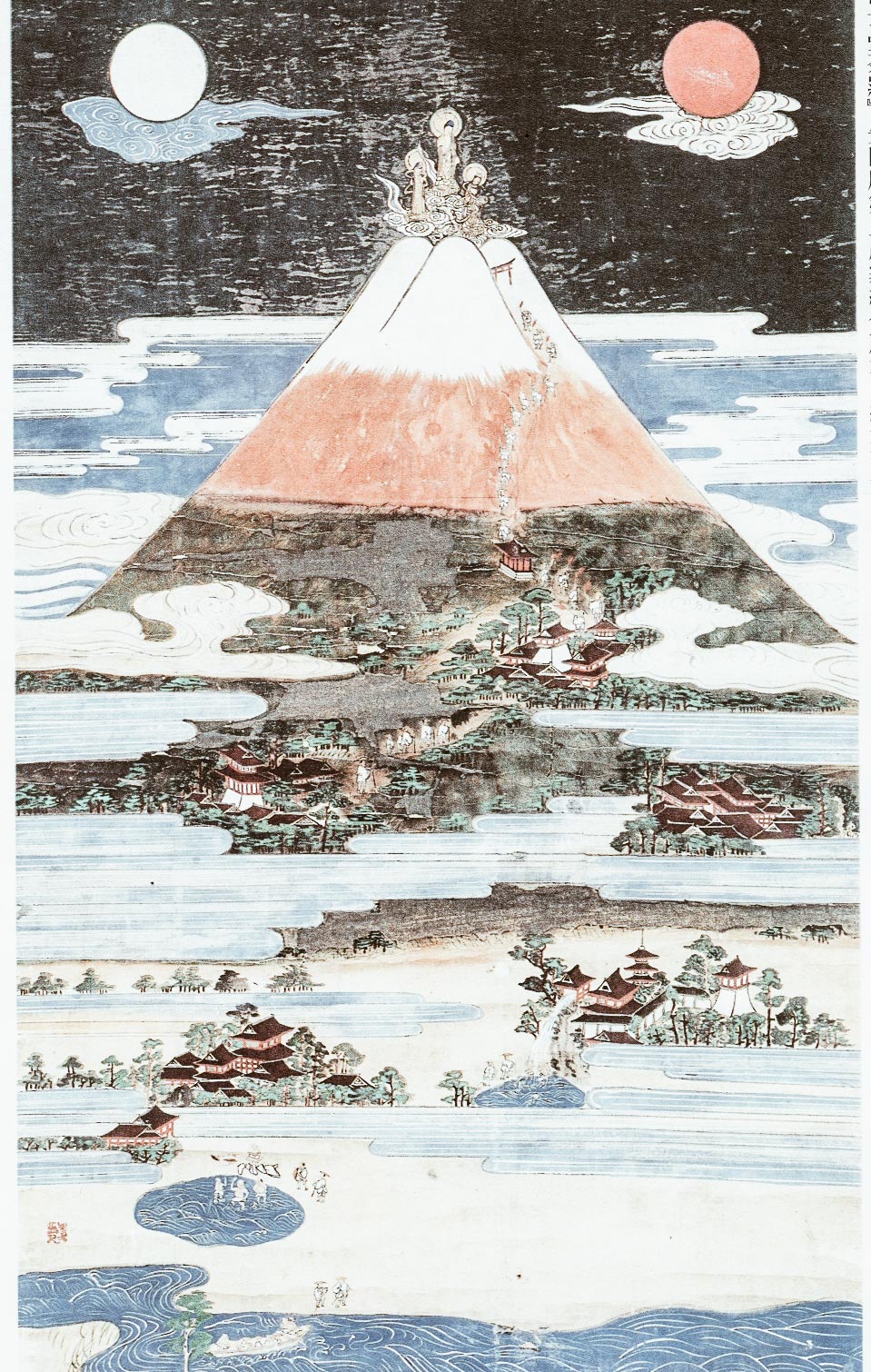

photo credits: medium.com/@jamesinjapan/
Meisho (名所): the Fuji in the arts
The meisho ("famous locality") are those places sculpted in the collective imagination because they were made famous by the Japanese arts. They are a reflection of that special relationship with nature from which the Japanese have always drawn inspiration. Nature is associated with moods and the image is the best way in which this people can give voice to their innermost feelings. Seasons, rhythms and colors of nature, places...become so essential, in their specificity, to express moods otherwise difficult to describe in words. The attention to nature is thus expressed through an aesthetic sense that transcends the very representation of the "object".
This tendency can already be seen in the Nara period (8th century), when the written tradition had not yet fully established itself. It is from this period the poetic anthology Man'yōshū (万葉集 "Collection of ten thousand leaves"). The Man'yōshū speaks of Fuji as a "mysterious" god, with "burning fires"; he paints it as an ideal mountain and highlights its importance as a protective deity. That one of the very first written works speaks to us immediately about Fuji is indicative. It means that the mountain was somehow "installed" in the collective imagination, like meisho, even before the passage to the written tradition! And this even though at that time it had not yet emerged as an absolute icon (although kami, it was still "only" one of the many existing sacred mountains).
Around the thirteenth century it began to become markedly more protagonist. In the Muromachi period it became central both as a religious subject (as in the Fuji Mandalas) and as a purely landscape icon (ink paintings in Chinese style). Among these, the "Eight Fuji Views" marked the beginning of Fuji's serial representations, inspiring in the Edo period the masterpieces of the masters Hokusai and Hiroshige.
Other famous works in which Fuji appeared: Literature Taketori Monogatari (竹取物語) and Ise Monogatari (伊勢物語) both from the 10th century; novels by contemporary writers Natsume Sōseki and Dazai Osamu. Visual Arts The 11th century Shōtoku Taishi Eden/Emaki paintings on roll; the Ukiyo-e woodcuts by Hokusai and Hiroshige from the 18th-19th centuries; and, of course, photography and cinema in modern times.
Climb Fuji to the present day
There are four possible access routes or routes to the summit. In ascending order of altitude:
- 1450 m, path Gotemba - the longest of all, without medical care centers, is not very popular;
- 2000 m, Subashiri trail - less popular and, perhaps because of this, devoid of medical care centers;
- 2300 m, Yoshida trail - the most popular, because it is easier and full of services (shelters, medical centers...) so ideal for beginners too;
- 2400 m, Fujinomiya trail - the shortest but also the steepest ever, has a medical center and is on average crowded.
All four start from 5ᵃ station (the term "station" indicates the level of difficulty of the climb): from 7ᵃ to 9ᵃ, the last one, the level is maximum. Between ascent and descent the total time is about 10-12 hours. It is therefore necessary to plan, and keep in mind that part of the ascent will be done at night. In fact, if you want to be present at the sunrise show - destination of almost all visitors - the advice is to calculate well the time in order to reach the refuge between 16.00 and 19.00. To rest until midnight, and then continue the climb for about 4 hours arriving at the top right, right for the dawn (at 4.30!).
The official climbing season runs roughly from the beginning of July to the end of August (maximum, until mid-September). Various Shintō ceremonies open the access to Fuji on July 1st and end with a big torchlight procession to the Yoshida sanctuary on August 26th. To venture outside of these dates is possible...but strongly discouraged! Since the climate is always severe and moreover, out of season, the shelters remain closed. In fact, every year, unfortunately, there are deaths, whether from avalanches, slippage, or frostbite... therefore, unless you are superman, don't go there out of season!
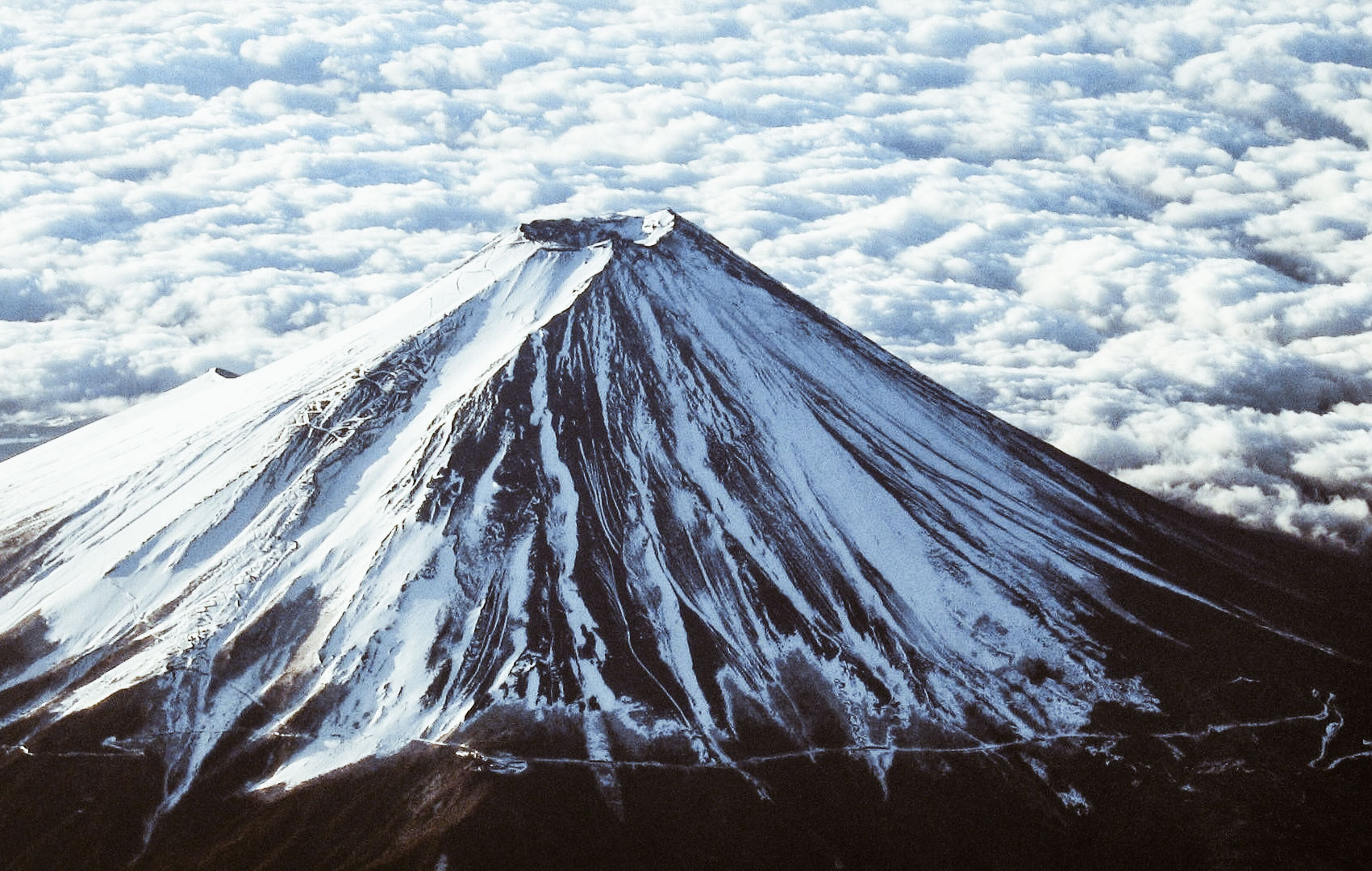
photo credits: linkedin.com
No to the "Bullet Climbing"
When climbing Fuji, it is recommended in any case to arrive at 5ᵃ station and stop there for at least a couple of hours, before resuming the ascent, so that your body can adapt to climate and altitude; to always hydrate a lot, in addition to taking several breaks during the climb. It is always not recommended, even more so for beginners, to try everything during the daytime hours to return at sunset. While starting the ascent early in the morning and taking it easy, it can be tiring. This is demonstrated by the upsurge in sickness following which the Japanese government itself was forced to dissuade itself from practicing "crazy climbs" or Bullet Climbing.
By the way: did you know that until the 19th century women could only climb up to the 2ᵃ station? There, they were made to wait for the return of their male relatives, but they went further. This is because at one time she was not considered capable of withstanding the harsh conditions of the mountain and that this would have hindered the practitioners in isolation. Just think that the first woman to climb Fuji in 1833 disguised as a man! Also from the 19th century, then, the first foreigners on the summit.
When and where to best admire it
The best seasons in which to admire it without the clouds constantly interfering, are always autumn and winter - from November to February. Especially winter, in December and January, which are played out depending on the weather and climate. Some years the visibility is better in December, others in January.
The visibility is not optimal instead between April and August, especially in the months of April, June and July, when it is particularly reduced; but also in September, being the latter period of typhoons.
In short, what is decisive in terms of visibility, more than the weather conditions (a sunny day is not equivalent to good visibility!), are the seasons.
Between late summer and early autumn, then occurs the phenomenon of Fuji Rosso so defined because of the color that the mountain assumes at dawn. Since the period in which it occurs is precisely circumscribed, assisting you is considered a good omen. In particular for business and fertility (it seems that the Japanese see in Red Fuji a woman in a state of interest!). In general, that brings good luck and makes one's dreams come true.

photo credits: ameblo.jp/ameba20091/
The best time of the day to observe it in full is always in the morning, especially at 8.00 am. The further you go in the day, the less it is visible for the whole day, the better.
From Tokyo it is visible - mist or clouds permitting - especially from: Metropolitan Government Palace in Shinjuku (on the 45th floor, free entrance!), Roppongi Hills, from the iconic Tokyo Tower, but especially from the impressive SkyTree. You can also do it from the 5th floor of Haneda International Airport, open 24 hours a day! Good to know, in case you are waiting for a flight right at dawn...isn't it?
To keep in mind also the location Miho no Matsubara (三保の松原), historical for the view of Mount Fuji. And, in spring, the spectacle of the "carpet" of Shibazakura, pink moss flowers that cover the meadows at the foot of the mountain. Every year the Shibazakura Festival is celebrated for the occasion (芝桜祭).
You can also get a great view from Mount Takao, 1 hour from Shinjuku, ideal if you have to stay close to Tokyo. Finally, a personal opinion: the view of Fuji rising against the backdrop of the city of Yokohama at sunset is simply wonderful. I could observe it from one of the mini cruises available in the bay.

photo credits: pinterest.it
Wabi-Sabi, introduction and detailed focus
What is Wabi-Sabi and why is it so fundamental for the Japanese? Accepting the natural cycle of growth and decay of reality. To grasp its meaning, its beauty. To live life as it is, without wanting to change its colours, and yet to fulfil your sense of life to the best of your potential. Japanese sensitivity and psychology could be traced back to these two elusive words alone.
Wabi-Sabi 侘寂 The most ineffable experience in the design of Imperfection
Guest Author: Flavia
In the world is often associated with design, but Wabi-Sabi is much more than that. Its origins are linked to those of the Tea Ceremony, therefore, the matrix once again is Zen.
It is actually an experience, translated into a worldview as well as a refined aesthetic sensibility, which would manifest itself when the highest form of something is achieved. A mix of emotions and feelings emerging from a state - an instant - of awareness that allows us to grasp the true nature of life's lights and shadows. So when we speak of beauty from now on, it will be understood in a broad sense, not only as aesthetic beauty in the strict sense. Also because, it is an aesthetic consciousness that encompasses the outward appearance, but also transcends it.
It must be said immediately that, since it is a metaphysical concept that we have in our hands, any attempt to frame it in words once and for all will always be risky. Therefore, the best way to know it remains to experience it directly. The fathers of Wabi-Sabi themselves - immediately realizing that a cognitive approach would not be the most appropriate - used images or allegories to try to render the idea. Even the modern Japanese, when questioned about the definition, tend not to throw themselves into verbal transpositions without the slightest moment of doubt. Or, each one, gives a different explanation according to his own sensibility.
It is with this awareness, then, that today we propose to explore with you this concept as mysterious as ineffable.
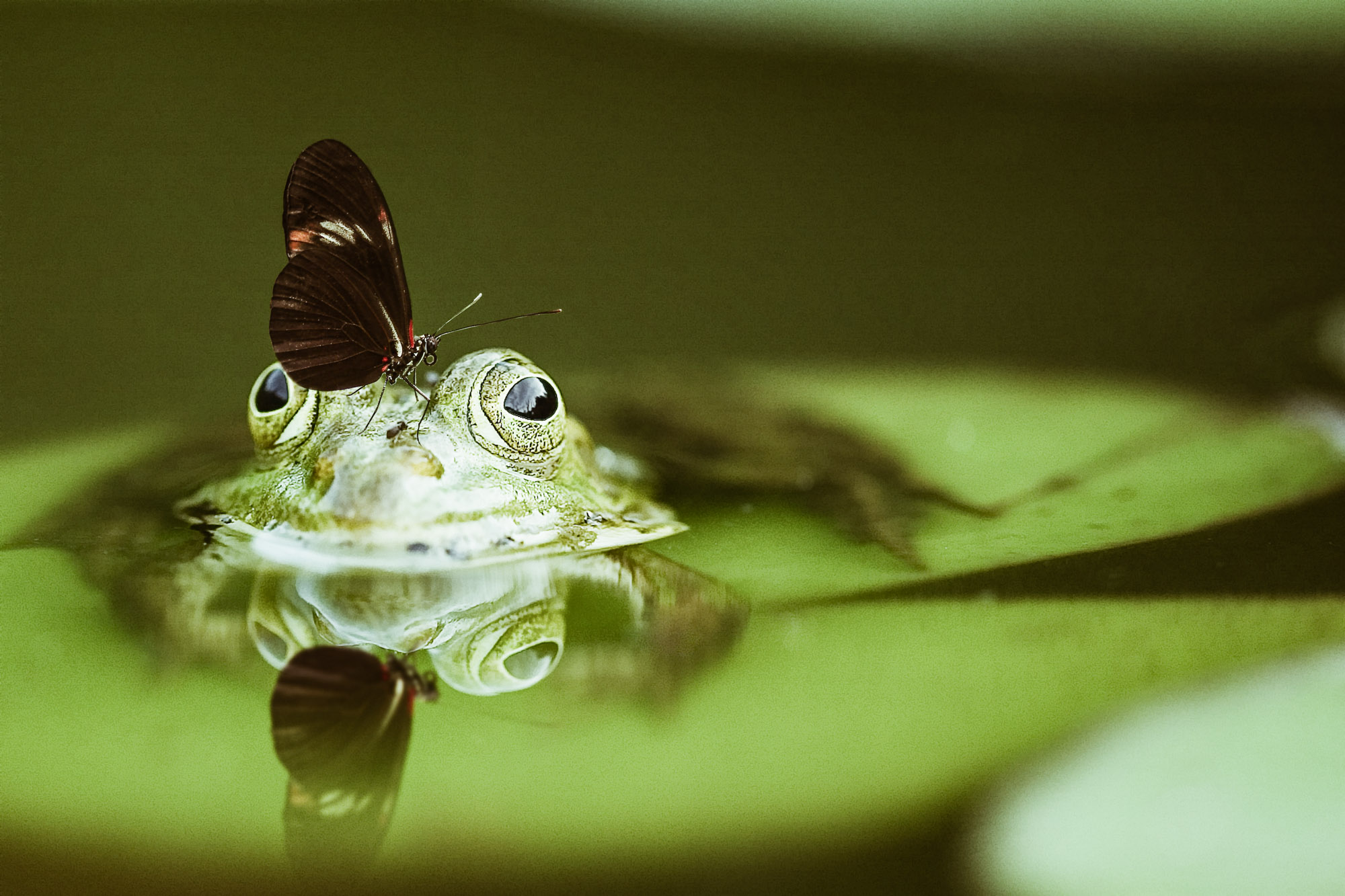
photo credits: reddit.com
Imperfection, Impermanence and Incompleteness
It is the trinomial par excellence to which the Wabi-Sabi aesthetic is irremediably conducted and synthesized. It refers to the Buddhist vision of life, whereby the beauty of things does not lie in the absence of defects or in eternity - which is not of this world - but in their imperfect and ephemeral intrinsic characteristics.
However, there seems to be something more in what Wabi-Sabi seems to reveal: Imperfection, Impermanence and Incompleteness would be a point of departure rather than a point of arrival. They would be the basis to keep in mind, in our co-creation with reality, rather than the summit of the mountain to be reached. In other words, it would suggest to recognize reality as it is, to be realistic: not to insist on forcing it to be something that cannot be, that is, perfect. But at the same time it would suggest - and that's the beauty of it - to do everything necessary to accomplish your task or role, given this base of imperfection, in the best possible way. Similar to what happens in Chadō, but on this, we will come back later.
Personally, I find that Impermanence and Incompleteness are also "sub-sets" of the mother concept of Imperfection. What else denote the impermanence and incompleteness of something if not its imperfection? Similar speech for the concepts of defect and beauty. They are different but they are also the same thing: the "ugly" can be referable to the size of the defect, ergo of the imperfection (which makes it beautiful). I believe that keeping this in mind helps to approach the Beauty discourse at 360°. Since Wabi-Sabi could refer as much to a work of art as to a situation or even a map.
Now, however, the time has come to finally get to know the terms Wabi and Sabi.
Wabi (侘) - Beauty and tranquillity in essentiality
Indicates a taste for simplicity and tranquility. From the linguistic point of view the Kanji - ideogram -「侘」è composed of the radical 「⺅」di person + 「宅」di home. Almost as if to visually indicate a person who, alone, is leaning against his little house. I use the verb "leaning" because that little man so placed inside a Kanji can be explained as if the little person was leaning against what is represented. Well, as we will see shortly, the original meaning of Wabi 侘 was one of loneliness.
The beauty promoted by Wabi is discreet by virtue of the presence of imperfections generated in a natural, spontaneous (never intentional!) way. Natural defects are the essential value of the object, the person or the situation. It makes them perfect ... and consequently, beautiful. A rustic or not ostentatious beauty that prefers the natural instead of the artificial.
Natural defects find space where functionality - and not form as an end in itself - is the main criterion of life. In other words, in simplicity. On the contrary, in sumptuousness or complicity defects are invariably suppressed: beauty thus becomes an end in itself. The exasperated complicity then, tends to accumulate concepts, thoughts, forms etc., weighing down with complex tangles what could be essential and therefore even more functional. For these reasons, Wabi seems more oriented towards Incompleteness and Imperfection.
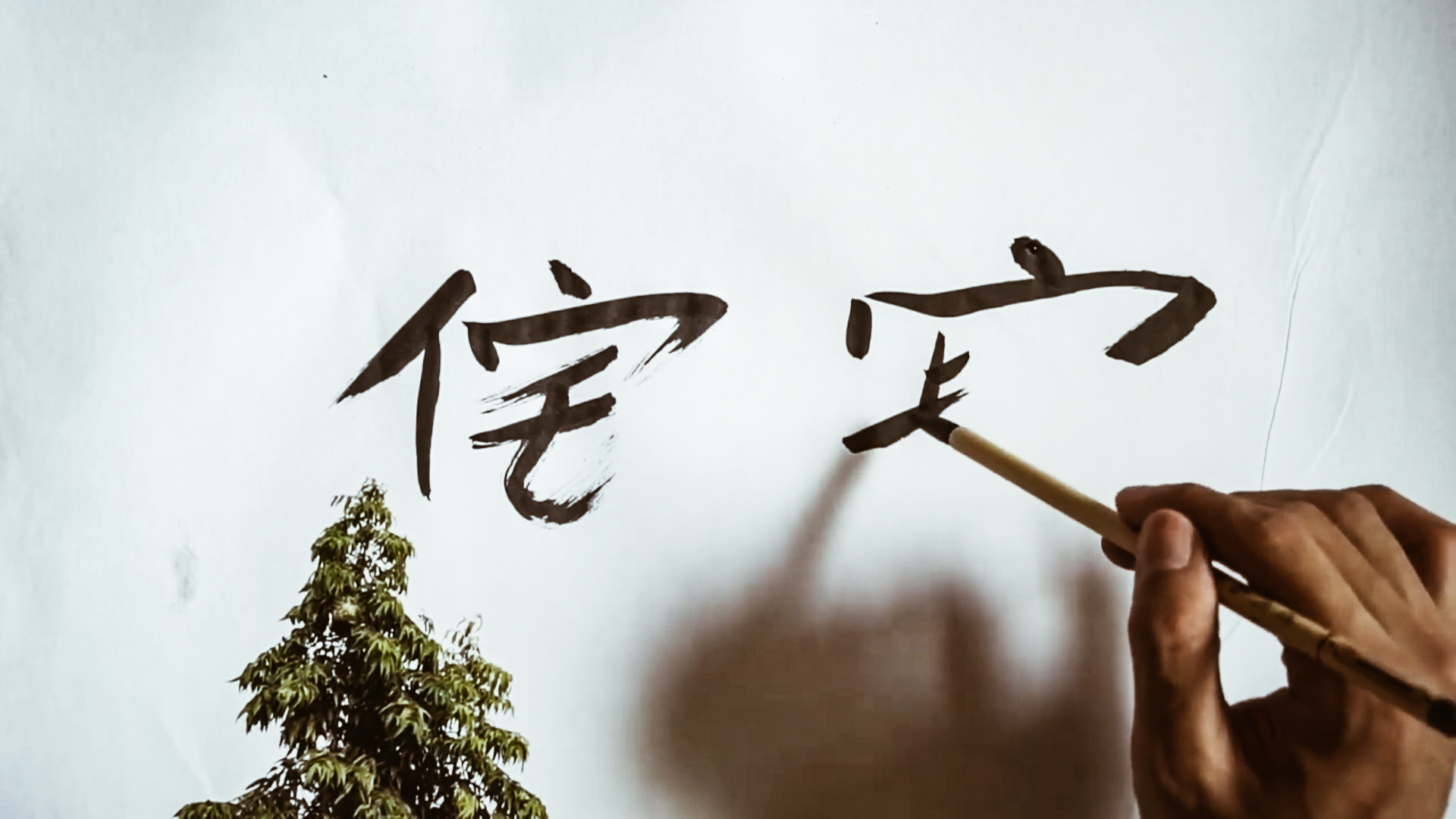
photo credits: youtube.com
Sabi (寂) - Beauty and quietness in the advance of time
The Kanji Sabi「寂」è given by the union of the radical tetto「宀」con kanji「叔」che may mean uncle or old or mature man. The suggested image is therefore that of a person in the final stage of his life under a roof. Going through the various meanings, the concept in the background refers in any case to an idea of decline or deterioration. The meaning of Sabi寂 is still today that of loneliness, desolation, calmness, maturity (think that the adjective 寂しい "Sabishii" means to be or feel lonely). And although they are written with different Kanji, the root of the Japanese words of "rust", "rusting" or "deteriorating" is pronounced by chance "Sabi".
Well, the beauty promoted by Sabi has to do with the passing of time. It enhances the intrinsic qualities of things and people that originated as a result of the effect of time on them (deterioration/aging but also experiences). Because it is only thanks to time that these qualities have been able to emerge in that particular way.
Then there is a message in the "wear and tear damage" that if we are able to grasp it, especially in time, it is of enormous value: that of reminding us that nothing, from objects to situations, is forever. And that therefore it is necessary not to "chinchishize" and seize that precious moment in which we can appreciate them because they are still here with us: now.
This is why Sabi seems more oriented towards Impermanence and Imperfection.
Wabi-Sabi, self example
But it was not always so. There was a time when such awareness was not yet there. Originally, in fact, the moods associated with Wabi and Sabi were quite low:
- Wabi, as anticipated, indicated a sense of loneliness; one to be on one's own associated with nature, in the style of hermit isolation.
- Sabi, for its part, denotes a sense of coldness or aridity, poverty, restriction, decay.
They had in common this dimension of loneliness and desolation... and the sense of melancholy for not being able to enjoy the company of their fellow men.
In short, they had their own low notes.
Usually, however, it is from the lowest notes that the best (re)births take place. And this is what has happened. With the advent of Zen Buddhism the general consciousness undergoes a metamorphosis and so around the fourteenth century the connotation of the two concepts is reversed.
- Wabi: isolation in nature is now seen in all its value and "rustic simplicity" revalued. Thus takes shape the pleasure for the quiet and simple life.
- Sabi: it evolves in the beauty of Impermanence that is the added value and serenity that things and people achieve with wear and aging.
Bitterness is now softened by mixing with it a sense of calm. The melancholy - given by an existential condition felt as miserable - thus turns into a bitter-sweet feeling that some have tried to define "serene melancholy" or "sad beauty". In some ways it might, at times, remind one of the Portuguese/Brazilian Saudade (also difficult to transpose verbally). But what it most strongly recalls is the previous Mono no aware (物の哀れ), another key concept of Japanese aesthetics.
Summing up: in their early days Wabi and Sabi represent nothing more than their shadow side. A dark version of themselves that "exorcised" from Zen, is born to new life. Abandoning forever the darkness in which they were born, illuminating themselves in those characteristics previously corroded by darkness.
The divine, essence of nature
The sense of austere and quiet beauty that Wabi and Sabi together transmit could only originate in the spiritual isolation of Zen Buddhism. Only in a state of mental and therefore spiritual stillness is it possible to observe joy and sadness alternating exactly like the cycles of nature and seasons. Joy for what has been or what will be, sadness for what has made its time or what is to come.
The only thing that always remains the same is stillness. A stillness given perhaps by this very certainty about the cyclical nature of things. Their coming to an end may generate some melancholy, but at the same time it gives us confidence, because we know that the time will come for a new rebirth, a new beginning. For this reason, nature is also a teacher of patience. Every end presupposes a new beginning, nothing really dies. In the present moment, however, the only thing we know is what is manifest in this moment, inside and outside of us.
Serenity and confidence in becoming, awareness and attention to what we see unfolding in the present moment: these, the only certainties of the human being present to himself.
If there is stillness there can be no fear. Serenity and fear are mutually exclusive. If fear manages to make its way, it means that, at least in that present moment, there is no state of inner stillness. To be able to understand all this, and perhaps to experience Wabi-Sabi, even a single moment of waking would be enough.
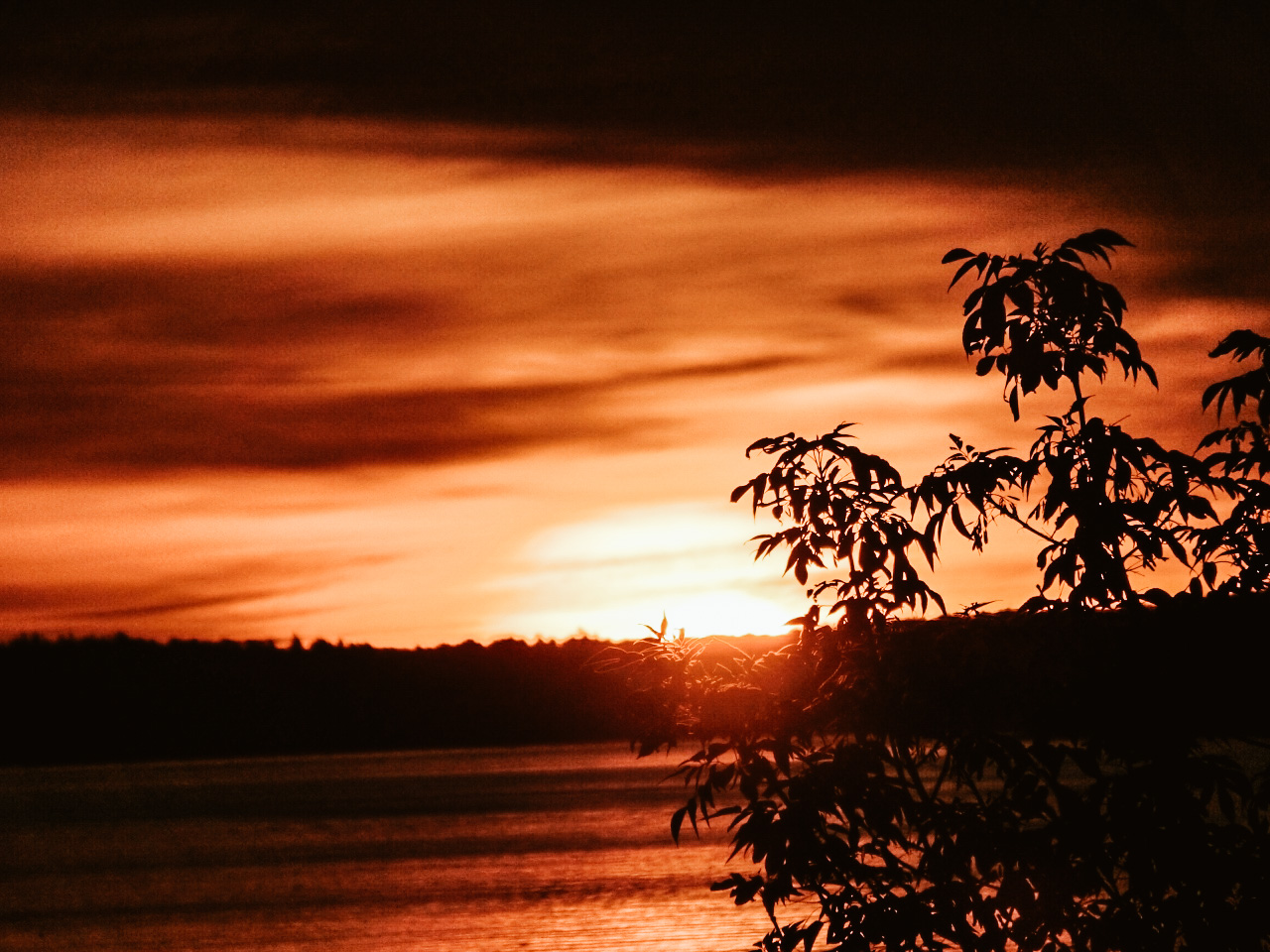
photo credits: 4travel.jp
«Kata–Katachi»: as diligent as nature
To accept the natural becoming, to let it flow, does not mean to become passive, to let oneself go to "disorder". The diligent execution of the gestures of the Tea Ceremony, in which Wabi-Sabi has its roots, shows us just that. As we said in the article dedicated to it, the principle of kata-katachi - common to all Japanese disciplines - aims at achieving harmony with oneself and the surrounding world. How? Through a constant, diligent repetition of certain gestures aimed at making these same gestures our own, to make them come natural to us.
This is the essential Japanese logic: observe-apply, simply; but apply diligently. And this is a bit what happens with the observation of nature itself. Observing the behavior of nature and replicating it could be said to be the very first great application of this principle by the Japanese people.
This suggests us, as we said at the beginning, that it would not be enough to stop to accept the Imperfection: but that everything should fulfill its task or function within the design of the Imperfection. For human beings, it is a matter of acting in their roles by completing everything in the highest possible version. In essence, giving the best of oneself.
And if in all this some "defect" wants to manifest itself, at that point, to welcome it, just because you have already done your part. Seize then the beauty of that defect, in truth so perfect in its imperfection, so complete in its incompleteness, just for having emerged in that way.
In this way we would be more like nature...dancing with it at its own pace. It is in such a frame that Wabi-Sabi could come. I could be wrong, but it would seem to be a moment between one cycle and another, an instant of silence between the cycle at the end and the next. An empty space where both times do not exist but, at the same time, are connected. As if it were a very thin, invisible thread, visible only at that juncture. It is in that moment of stasis, where the boundaries between outside and inside are missing, that Wabi-Sabi could manifest itself.
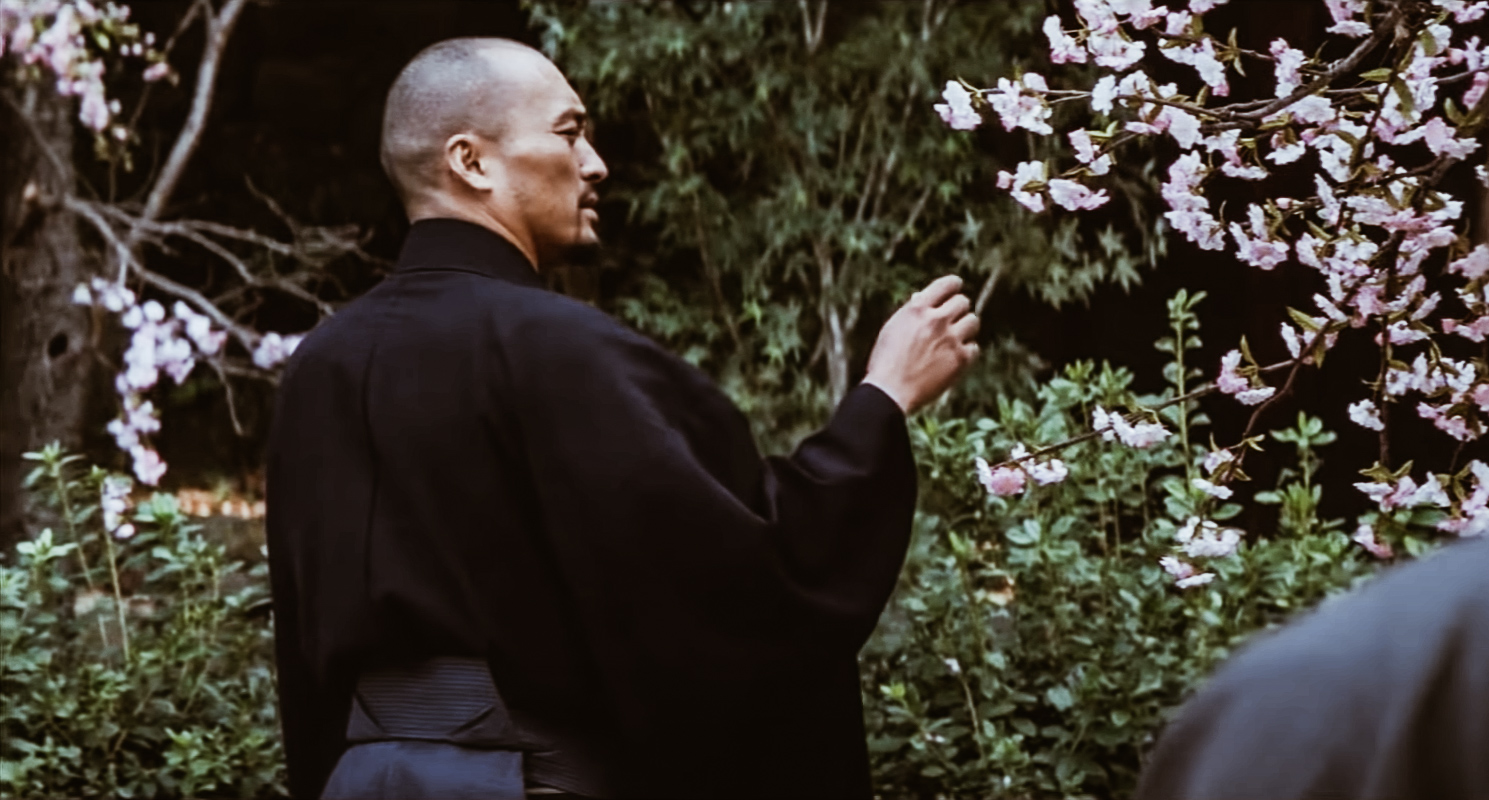
photo credits: Film The Last Samurai
Imperfection as a "touch of the divine"
The perception of Wabi Sabi would therefore seem to emerge where a degree of awareness has been reached such that there is a detachment from the idea of absolute perfection. One understands the sense of imperfection and transience of things and one can grasp its spontaneous and genuine beauty. You welcome it as an added value - divine touch - to your creation: it is a balanced beauty.
Knowing how to recognize that Imperfection is the touch of the divine implies understanding when it is time to let go of your "brush". It is necessary to know how to let go when everything that had to be done has been completed and the feasible moves all exhausted. To get caught where our task is finished or to try to intervene on the "touch of the divine" - not recognizing it as such - is certainly a point where Wabi Sabi cannot emerge. Because it lacks its basic fertile ground: tranquillity.
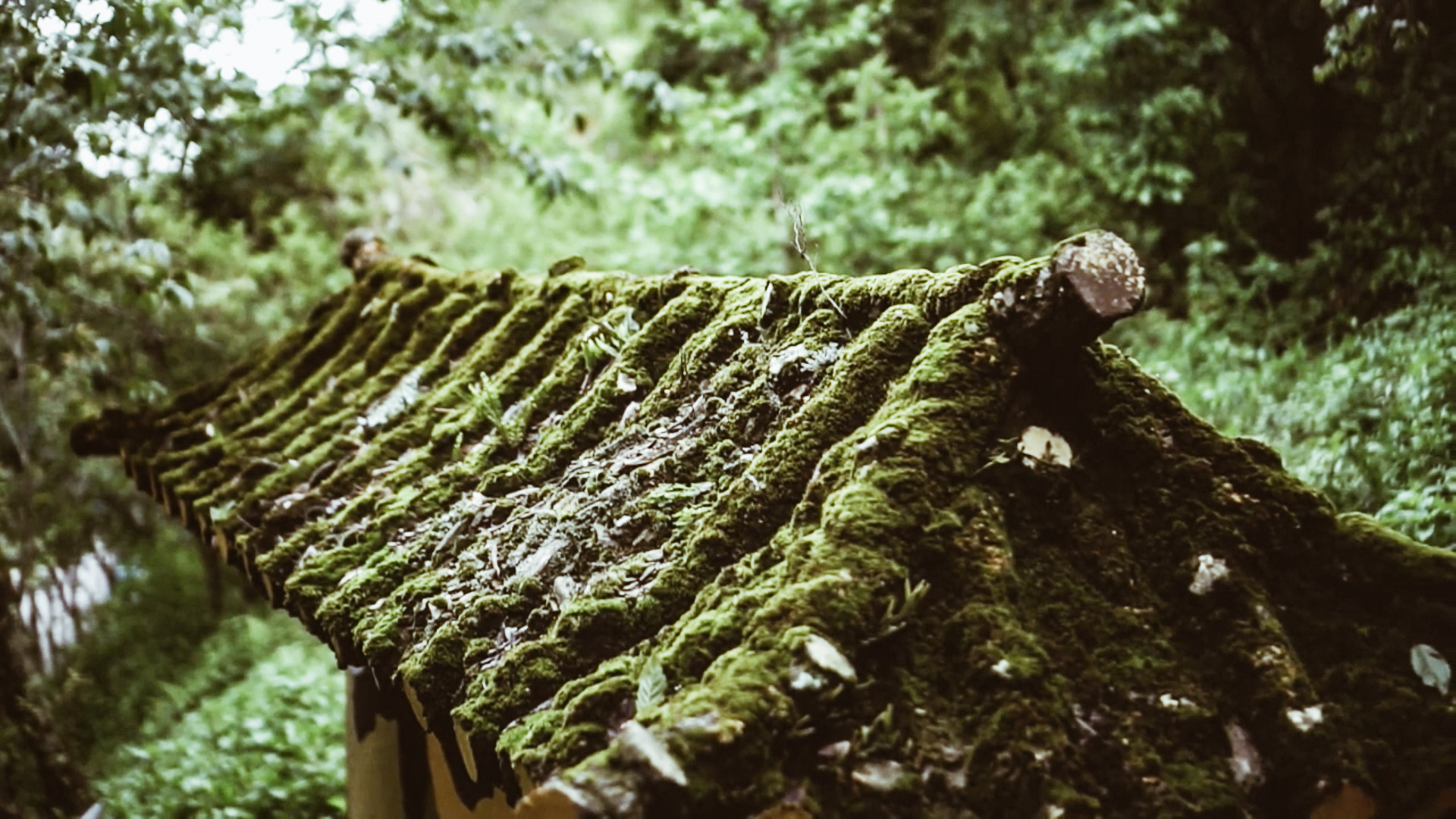
photo credits: youtube.com
Wabi-Sabi, the origins: the Buddhist vision
The principle that is the premise of the Wabi Sabi experience is to be found in the Buddhist philosophy of the Three Signs of Existence, so everything that manifests itself in this reality is subject to three characteristics:
● Impermanence
Everything that is, outside and inside us, is destined sooner or later to leave room for something new. It is a constant cyclical becoming in which everything that has a beginning also has an end. Moreover, the very existence of matter is regulated by duality: everything necessarily manifests its opposite. This is because the One, in matter, must necessarily split into two parts. If an element of a binomial (beginning-end, light-dark, positive-negative, male-female, birth-death...) is missing, imbalance is generated... because they are two aspects of the same thing. You may like it or not, but that's how matter works. Therefore - as long as you are in it - it is not possible to escape such laws.
● Insubstantiality
Nothing is random: each event derives from the concatenation of n factors even very far away in time and space. Therefore nothing exists, in itself, as a manifestation independent of what originated it. There is therefore a link between all the things of the world, so apparently disconnected from each other, including our human Self. By participating in the changing nature of reality it can only be fragile, incomplete: therefore, much emphasis is placed on disidentification from that part of oneself. The unharmonized Ego tends to draw sap from material reality alone, making us remain trapped in the temporal illusion of past and future. Thus also allowing other types of illusion to make their way. That is why the present moment, the attention to the here and now, is essential.
● Suffering
Nothing in the world will ever generate lasting satisfaction. At the very moment when there is happiness, its end is inevitably written in it (it is the law of polarity). And in fact, the true existential goal to be set is Serenity, not happiness. Only Serenity can guarantee constant well-being, even in dark moments, because it is born of Presence. Happiness, as beautiful as it is, is nevertheless the child of emotions. Therefore, of duality.
Accepting this vision of things allows for greater realism. Become aware of how things are, accept, adapt and thus understand how to move in reality. Develop a healthy, lucid, vision of the reality around us is essential to move in this world.

photo credits: youtube.com
Zen philosophy, fertile ground for Wabi-Sabi
Eliminating the root of suffering is therefore possible: the key lies in adapting to the nature of reality as it is. Suffering originates precisely from a denial of reality: from resistance, from attachment. That is, from control, dictated by fear, which does not allow things to flow. But what gives rise to this fear? Probably, from the mistaken belief that imperfection somehow leads us to existential ruin. As if every time, we risk to die.
Instead it makes no sense to resist something that is bigger than us, on the contrary it gets worse. It is to want to sail against the current. Such is the physiological nature of the reality that surrounds us: isn't it better to "make friends" and find a way to collaborate?
Here then are the "tips" of Zen philosophy for a more balanced and serene life:
● Perfection does not mean absence of defect
The imperfection of something does not qualify it as negative. The perception of what is "defect" or "ugly" is also relative. It varies from civilization to civilization, from person to person...even within the same person. And if by hypothesis they were fixed law, there would still be a precise reason for being, wouldn't there? In order to internalize this vision, however, it is essential to acquire an important state of mind: non-judgment.
● Accept Transience and Imperfection
Why reject something that is a structural part of the reality in which we live? That's just the way it is. It is wiser to accept what is not in our power. And still keep an open heart! Because the same Impermanence, which we fear so much, often reserves us pleasant surprises and opportunities.
● Remove all that is not needed
To free oneself from unnecessarily necessary things in favor of a more direct and deeper contact with the things of our life, starting from the most "insignificant". Their essence, their meaning, their beauty...become so perceptible. To relieve ourselves from the useless superstructures with which we often tend to weigh everything down and which distract us from simplicity - which alone would be enough to make things flow even more efficiently.
● Live the present, detached from the result.
There is no such thing as the perfect moment. Chasing an objective at an imaginary point in the future is a trap: the future, in itself, simply does not exist. The "never having enough" signals the onset of the second trap. You become the so-called hamster in the wheel. This doesn't mean that you don't have to have goals: it simply means to set the right goals but, let them go, without obsessively staring at them, losing sight of the present.
How Wabi-Sabi is rooted in the Japanese spirit
However, we can't leave ourselves, given our common origin with Wabi-Sabi, without remembering Chadō. Previously we have already had the opportunity to enter the Tea Way. In our dedicated article we have seen how the Tea Ceremony has gradually evolved from the more opulent form Shoin to Wabi-cha (Cha 茶 means tea). At the head of this "Wabi-cha", a direct line of Zen masters. Murata Jukō and Sen no Rikyū in particular, are still considered the fathers of Cha no Yu. In addition to them there will be another character to anchor the Wabi-Sabi in another important area of the Japanese cultural scene.
Here then is a snapshot of the historical evolution of Wabi-Sabi:
● XII century
It all begins with Myōan Eisai, a Buddhist monk from the tent school. Eisai is the one who brings from China the Zen doctrine (Rinzai) and with it the use of tea, thus paving the way for the development process of the Tea Ceremony.
● XIV century
The terms Wabi and Sabi undergo that semantic metamorphosis of which we spoke at the beginning. Their meaning begins to overlap and they gradually begin to use them together. For example, they will notice the rustic objects that will increasingly take the place of the luxurious Chinese objects typical of the initial Shoin-cha.
● XV century
Murata Jukō makes his appearance. With the approval of the Shōgun Ashikaga Yoshimasa, he manages to introduce the Wabi style in the practice of tea that spreads in the country. Jukō acts for example by reducing the number of utensils of the ritual, thus bringing more attention to them (remember, take away what is necessary).
● XVI century
It is the turn of Takeno Jōō, a student of Jukō, who instead focuses on the simplification of the tea ritual environments. For example, he introduces more modest materials such as clay, bamboo and removes wood from some parts. In antithesis to the Shoin style, he also brings the use of indigenous objects on a par with those of Chinese origin.
The student of Jōōō, Sen no Rikyū, the most revolutionary of all, will complete the work by codifying the Ceremony once and for all.
● XVII century
Matsuo Bashō, the greatest Japanese poet, will transpose Wabi-Sabi into poetry. During his long wander in solitude in the nature of Japan he will succeed, just like a painter with his canvas, to capture its images. The success of his Haiku compositions, so essential, silent and empty, lies in having used words to paint the situations and landscapes he encountered rather than describe them.

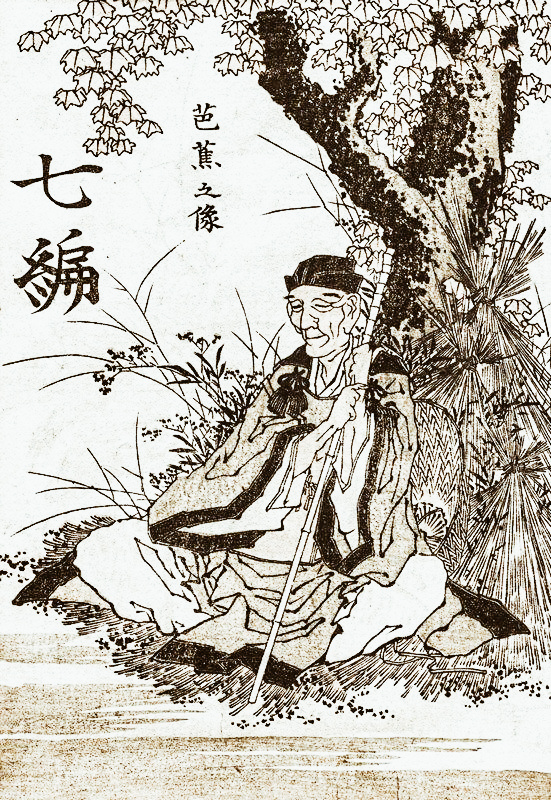
photo credits: angelotrapani.wordpress.com, allpainters.org
Balance is the matrix of everything
At the end of our journey through the "landscapes" of Wabi-Sabi we have understood that the underlying condition of everything is inner peace. We must be silent inside ourselves and silence everything that makes noise inside us. In other words, we need to (re)establish balance. Order, balance...if you pay attention to it, you always go back there. Too much of anything generates imbalance.
The secret to make friends this reality resides instead in learning to move in duality, in knowing how to govern the extremes.
We have also understood that letting reality flow includes our range of action. For us too, just like nature, to fulfill our function in the highest form of expression possible. Instead, we should not be confused with a passive letting ourselves be overwhelmed by events which, on the contrary, is an imbalance in everything and for everything.
Passiveness and control, two sides of the same coin.
The error of us Westerners, for example, more than in our idea of beauty per se, lies in our negative approach to Defect. We have always culturally recognized beauty in flawless perfection. Which, in itself, is not wrong: it indicates that we have well understood the metaphysical nature of the divine which, as such, has no defects.
However, we have not calculated one thing: that "original" perfection is not of this world! And so, in our search for the meaning of life, we try at all costs to bring that kind of perfection here. Not understanding, that this part of the Universe is designed to be imperfect. And that the divine, in these parts, also manifests itself through the defect (indeed, often the Imperfection is the most direct manifestation of it). Our misunderstanding is all there.
Imperfect means simply imperfect. We abandon judgment because it precludes us from seeing a whole spectrum of possibilities, making us remain confined in a narrow slice of reality.
Defective, 100% Western friends, does not mean absolute evil: let's drop this illusion. If evil can be spoken of, then this should rather be sought in the imbalance. For it is imbalance that prevents us from being quiet, lucid and present to ourselves.
And it is only in quietness that, when we least expect it, in a moment of emptiness we can suddenly find ourselves, from the divine point of view. From there, "from above", magically, we will be able to see the dance of duality and there our human nature will return melancholy to remind us how, for the moment, we are part of that dance.
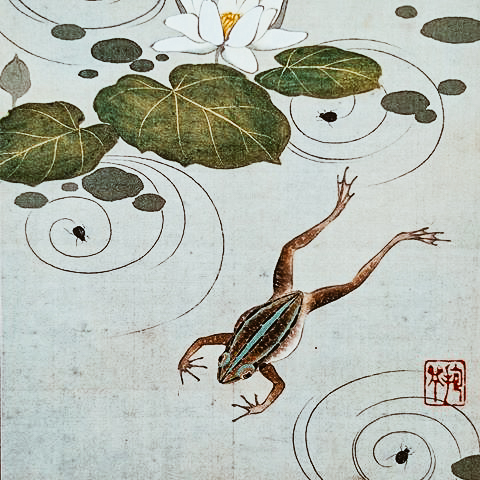
photo credits: wakuwakumedia.com
Chadō, the Japanese Tea Ceremony
If there is anything in which the Japanese are true masters is in living in harmony with life itself, this is demonstrated by the Japanese tea ceremony, also known as Chadō. A real gift, their innate ability to flow naturally with everything that happens from the smallest everyday gestures. Rooted in the here and now, fully in tune with the present moment.
Chadō, the Japanese Tea Ceremony - 茶道
Guest Author: Flavia
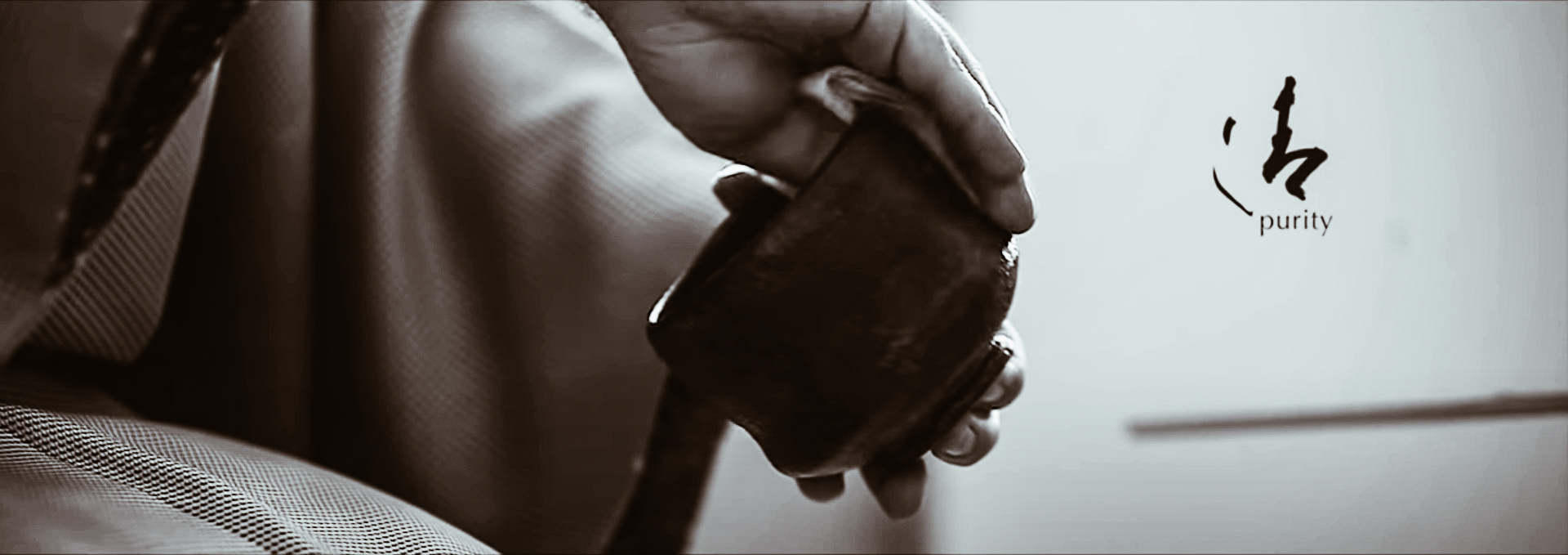
photo credits: YouTube
Therefore, it's not surprising that the people of the Rising Sun have been able to translate this extraordinary talent into various forms of art. They are in fact real ways of living (the so-called Ways - 道, Dō) through which to express their ability to grasp the meaning of existence. The Chadō or Sadō ( 茶道 ), or the Way of Tea, is one of the most significant and appreciated. Otherwise called Cha no Yu (茶の湯) - literally "Hot water for tea" - it is a social ritual aimed at educating the individual. A true philosophy of life and aesthetic form that has strongly permeated Japanese culture. But how did this tradition originate?
The matcha, from southern China in the bosom of Zen
Originally from the Yunnan region, the tea plant has been known for its therapeutic properties since ancient times. Initially, it was in fact used as natural medicine, it will only become a form of "delight" later. It was consumed in a monastic environment, being used by monks to promote concentration during meditation or studies. However, it will land in Japan at the beginning of the Heian period at the hands of Japanese monks who went to China to study Zen (禅, from Chinese chan).
Tradition attributes in particular to the monk Myōan Eisai - who lived between the 12th and 13th centuries - the role of the precursor of the tea ceremony. As it happened, he introduced in Japan the form of Rinzai Zen Buddhism (Linzhi or Linji, in Chinese) and with it a specific method of preserving and preparing tea. In essence, it provides that tea is kept away from light and oxygen and prepared according to the method of suspension (instead of infusion): this allows to better preserve its properties. The tea associated with the ceremony will become known as Matcha (抹茶), that is powdered tea. Actually, from that moment the consumption of tea will begin to spread on a large scale, leaving the monastic and aristocratic circles where it had been confined until then.

photo credits: tesoridoriente.net
Therefore Tea (Cha, 茶) has its roots in the Zen doctrine, which will remain decisive also for the diffusion of Chadō, inexorably permeating it. Zen and theism, therefore, developed at the same pace (since the 12th century). A key role here will be played by the equally nascent Samurai class destined to dominate the scene shortly afterwards. The caste will welcome the Zen doctrine, which will make it totally its own, and the cult of tea as a sort of status symbol.
Rikyū, father of Cha no Yu
After Eisai, other masters will leave their mark on the Chadō still in "embryonic" form. This is Murata Jukō, father of the Wabi-cha style ( 侘茶 ) - already well distinctive of the Japanese style compared to the Chinese one - and Takeno Jō. However, at this stage it cannot yet be configured as a real ceremonial rite. It will be necessary to wait until the sixteenth century for a real codification to take place and transform it into the form that has reached our days.
Creator of this reform, none other than the historic tea master of Oda Nobunaga and Toyotomi Hideyoshi, Sen no Rikyū, whose imprint will be revolutionary. He will go further than Murata Jukō, completely undermining the aesthetic taste of the Shōgun. Before his intervention, in fact, the execution took place focusing on the objects, that is, thought of their performance. With Rikyū, the focus becomes the people and the ceremony becomes less elaborate and more essential. In addition, he sets real rules around the concept of wabi ( 侘び ) - i.e. the beauty that lies in the essentiality and simplicity - applied to the performance of the ceremony and the gestures to be performed. The important Zen vision of Wabi Sabi ( 侘寂 ) - which we will have the opportunity to deepen in a next article - is thus consecrated as a pivotal concept, soul, of Cha no Yu.
Chadō, the four founding principles
4 are the principles Rikyū summarizes for the performance of Cha no Yu. They concern both the people who take part in it and the tools used as well as the room itself. Naturally borrowed from Zen aesthetics, they are:
- Wa (和), Harmony. The absence of imbalances or extremism in the interaction between the surrounding environment, things and people. Particular attention is paid to the interaction between guests and landlord: putting guests at ease becomes a pivotal point.
- Kei (敬), Respect. Recognition for the existence of things and people. A sincere soul is necessary: only an open soul will be able to perceive things and people in their true essence (kokoro, 心) and thus enter into authentic communication.
- You are (清), Purity. The absence of attachment to earthly things. Without such purification, true communion with the All is unattainable. It is taken up symbolically from the roji stone path (路地) placed in the gardens outside the tea houses. The variety of shapes and distances between the stones is not by chance designed to educate the guest already from outside to a conscious exercise of attention.
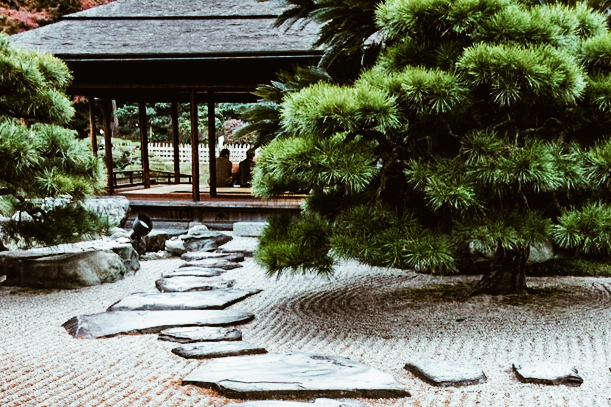
photo credits: iaininjapan.deviantart.com
In a way, the tea ceremony already begins in the garden. Because it helps those who walk this path (a Way) to harmonize with nature even before they set foot in the tea room. The principle is also "evoked" by the symbolic purification of the participants who, once invited to enter by the host, must rinse their mouths and hands.
Jaku (寂), Serenity. The state that is achieved in a natural way by the practice of these three principles already from daily life.
If the hearts of all those present will be open and receptive to the emptiness of that moment if the mind will have left that outside world beyond the garden: a harmony will be born so deep that environment, things and people... will become one. In a perfect fusion where dualism dissolves and it is no longer known where the boundaries of one or the other end or begin.
Chadō, Less is more: beauty according to the Japanese sensibility
In this perspective, negation becomes a positive value, the state of mind par excellence. This is reflected in the research of a frugal style which avoids ostentation and superfluous, already starting from the tea room, the Chashitsu ( 茶室 ).
The latter must be devoid of excessive earthly elements: in the Zen perspective of the master Rikyū it is necessary to limit sensory stimuli as much as possible. Leave space to the void, in order to empty the mind. Then the void itself will give space to the sounds that spontaneously emerge from it and that otherwise too many sensory stimuli would end up eclipsing. Sounds thus assume greater depth and the consciousness is refined. Perception is in fact amplified thanks to silence not only auditory but also visual, olfactory, tactile and gustatory. The senses are literally educated not to be dependent on stimuli, but in this way, they become more receptive. It may seem paradoxical to most people. But if you who are reading have so far understood the sensitivity that underlies this philosophy, you will certainly have understood this too.
The room must, therefore, be minimal, not so much illuminated, "intimate". It must be welcoming. Verbal interactions must be reduced to a minimum, also because non-verbal communication can be done here. Everything is designed in order to create a meditative atmosphere - typical of Zen. It is therefore recommended that we keep our eyes ajar in order to let the images that come into our field of vision flow, avoiding our sense of "feeling" them too much.
The semi-darkness of the room gives back value to the other senses other than sight, usually a little overwhelmed by it. The touch, for example, that emerges in contact with the teacup, in particular, if it is raku ( 楽 ), a symbolic cup in Chadō and Wabi Sabi because of its imperfect shapes that make it unique and unrepeatable. Or, in the case of the traditional Wagashi ( 和菓子, literally "Japanese sweet" ), where the dominant sense would be the taste, we find, on the contrary, also the sight and the other senses involved in a superfine way. But let's dwell on the concept of unrepeatability.
But let's dwell on the concept of unrepeatability.
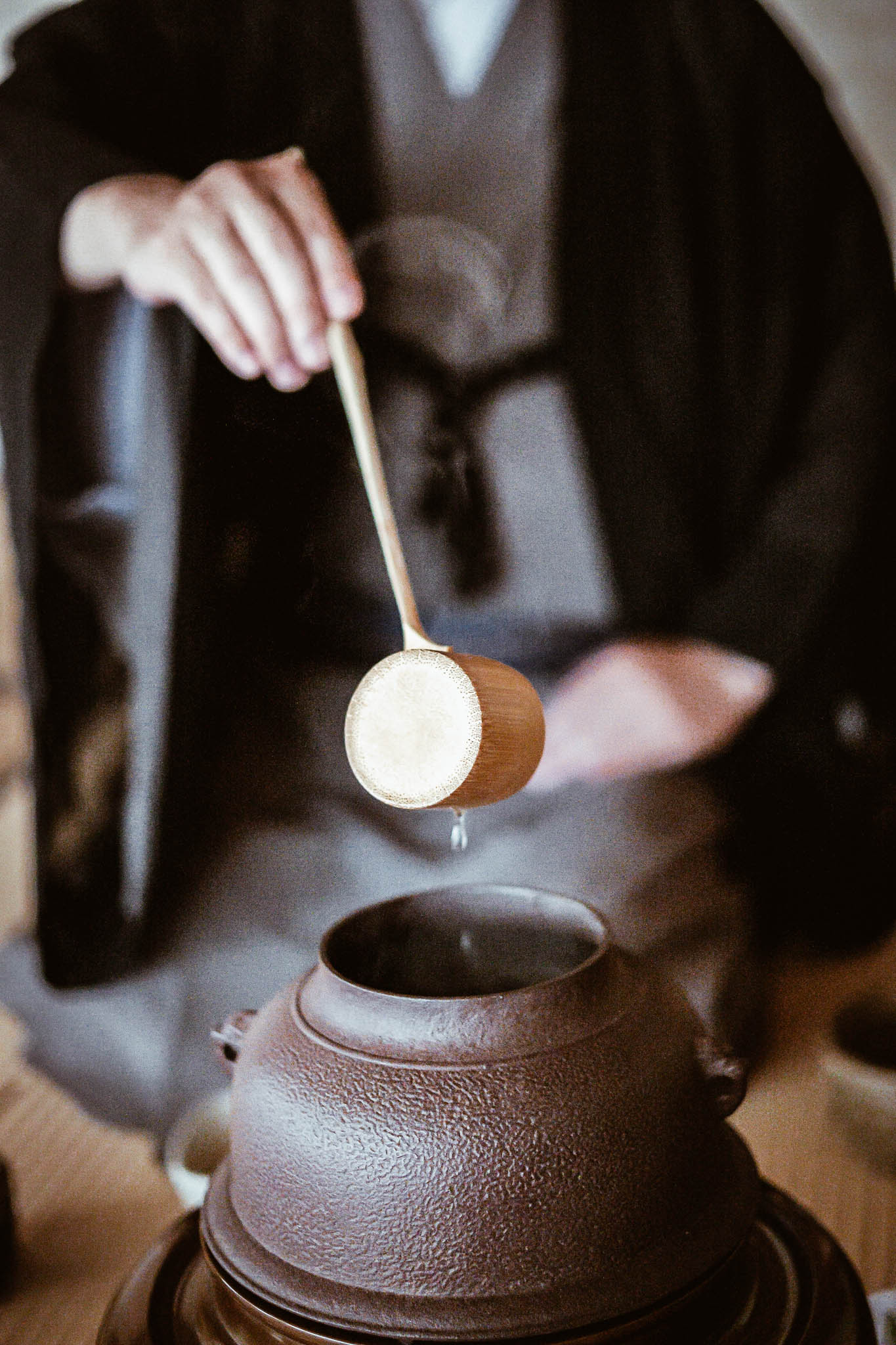
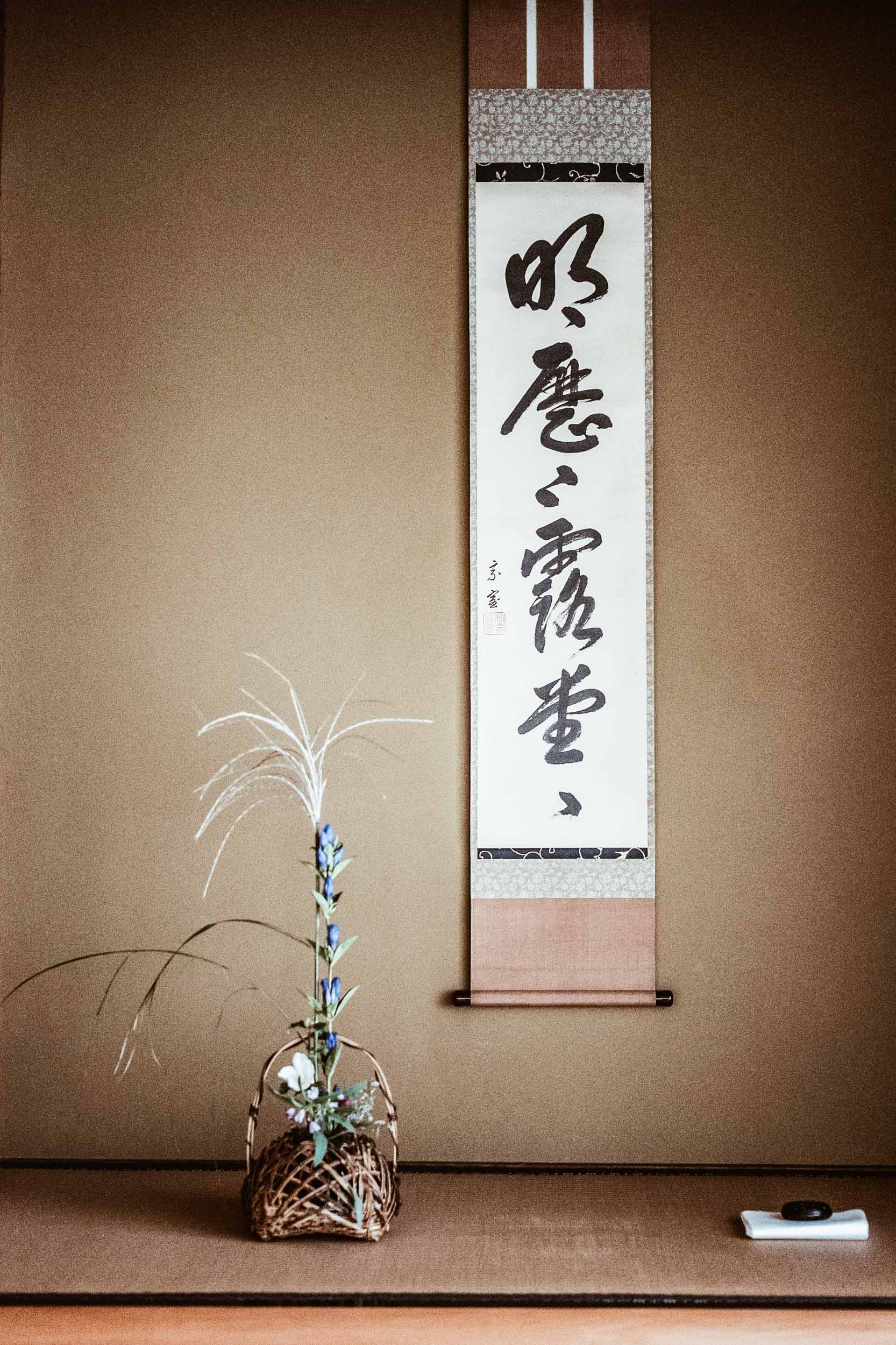
photo credits: moroalberto.com
Ichi go, Ichi e (一 期 一 会), the metaphor of life
Literally "once, an encounter", Ichi go-Ichi and is a Zen expression that refers to the idea of transience. It reminds us how every single encounter is unique and unrepeatable. Yes, in time we can repeat the ritual of Chadō as many times as we want, but each time remains unique in itself and distinct from the others. The atmosphere experienced in each encounter can never be the same the following times. Therefore, each one of them should be appreciated...as an encounter that happens only once in a lifetime.
So in Chadō, so in life: let go past and future. To take from them the knowledge we need for our learning, yes, but just enough not to get stuck with our minds. Otherwise, we run a risk: that of not appreciating in time the things that are with us here and now. Remaining, in that case, with the regret of not being able to see them in their value (remember the Kei, Respect) when they end their time in our lives.
That is when Zen wisdom comes to us, reminding us that this is the time to focus on, in the here and now, appreciating as much as possible what you have now that you have it. You have to live now and live it, in every single unrepeatable moment. But then again, what is the art of Cha no Yu if not life itself?
Kata - Katachi: When form becomes part of you
In Chadō every gesture is not random: movements and breathing must be harmonized, in order to transmit serenity in giving that cup of tea. You should know that Japanese culture attaches great importance to the concept of form (kata, 型), i.e. gestures codified by certain principles. Not schemes that are an end in themselves but a way to achieve a body-mind-spirit fusion and consequently harmony with existence itself (the concept permeates their vision of the world to such an extent that it also has its own small linguistic form).
When a practitioner arrives at embodying kata to the point that they no longer feel as something external to themselves - to be "staged" - then we speak of katachi ( 形) or "internalized forms". Through kata the practitioner learns patience, precision, resilience...and is forged from them. Final goal: the attainment of harmony with oneself and the surrounding world.
Observe-execute, to the point of internalizing: this is the basic approach of all Japanese art forms-disciplines. It is really part of their soul. They do nothing but decline this feeling in various areas of life. A way of life (the Way) that gives rise to forms of art and discipline which, in turn, guide the individual's path of life. A perfect circle that closes...
But the search for the perfect gesture carries within it another magical gift, that of dilating time. The present moment is crystallized and in that moment the depth of the senses puts us in communion with nature.
But beware: it is not an escape from reality. Sometimes for the human mind, the boundary between the two can be very subtle, but it is a mistake: to shun reality means in truth to alienate oneself from being present. No escape, therefore, as well as no attachment (two extremes of avoiding). But lucid, conscious fusion with what is happening in that place, in that moment. With reality.
The Way of tea, therefore, requires a true psycho-physical discipline about oneself and long preparation. So much so that in the process of self-improvement - as in any self-respecting spiritual discipline - the practitioner can be hindered by the human emergence of feelings such as laziness, apathy or other grey areas.

photo credits: moroalberto.com
The ceremony
The ritual is very complex, especially in its extended form. There is, in fact, a traditional version lasting four hours(!) reserved for formal events (Chaji, 茶事 ) and a reduced version for informal occasions (Chakai, 茶会 ). Likewise, Chashitsu can be distinguished in small (Koma, 小間) or large (Hiroma, 広間). The Koma is the wabi-cha room par excellence, while the Hiroma is well suited to more official circumstances.
During the ceremony, the tea water is boiled in an iron or cast iron teapot. When it is ready, pour some into the ceramic cup where the matcha was previously brought. Then, the whole thing is beaten with a bamboo whisk. The appearance of foam indicates that the tea can be served.
But let's see what happens depending on whether we're in a formal or informal event.
茶事Chaji
- Before tea. Since drinking and eating never go hand in hand, the traditional Kaiseki meal is offered first ( 懐石o会席 ). After the meal, Wagashi are offered at a later stage. Different Wagashi will be paired according to whether the tea is dense or not (as we will see shortly also in the Chakai).
- Usucha. The guests individually drink a whole cup of tea, this time no denser, they dry the edges of it and give it back to the master who in turn washes it, dries it, and prepares it for the next guest.
The ceremony in this form is very elaborate, so breaks and even room changes are envisaged.
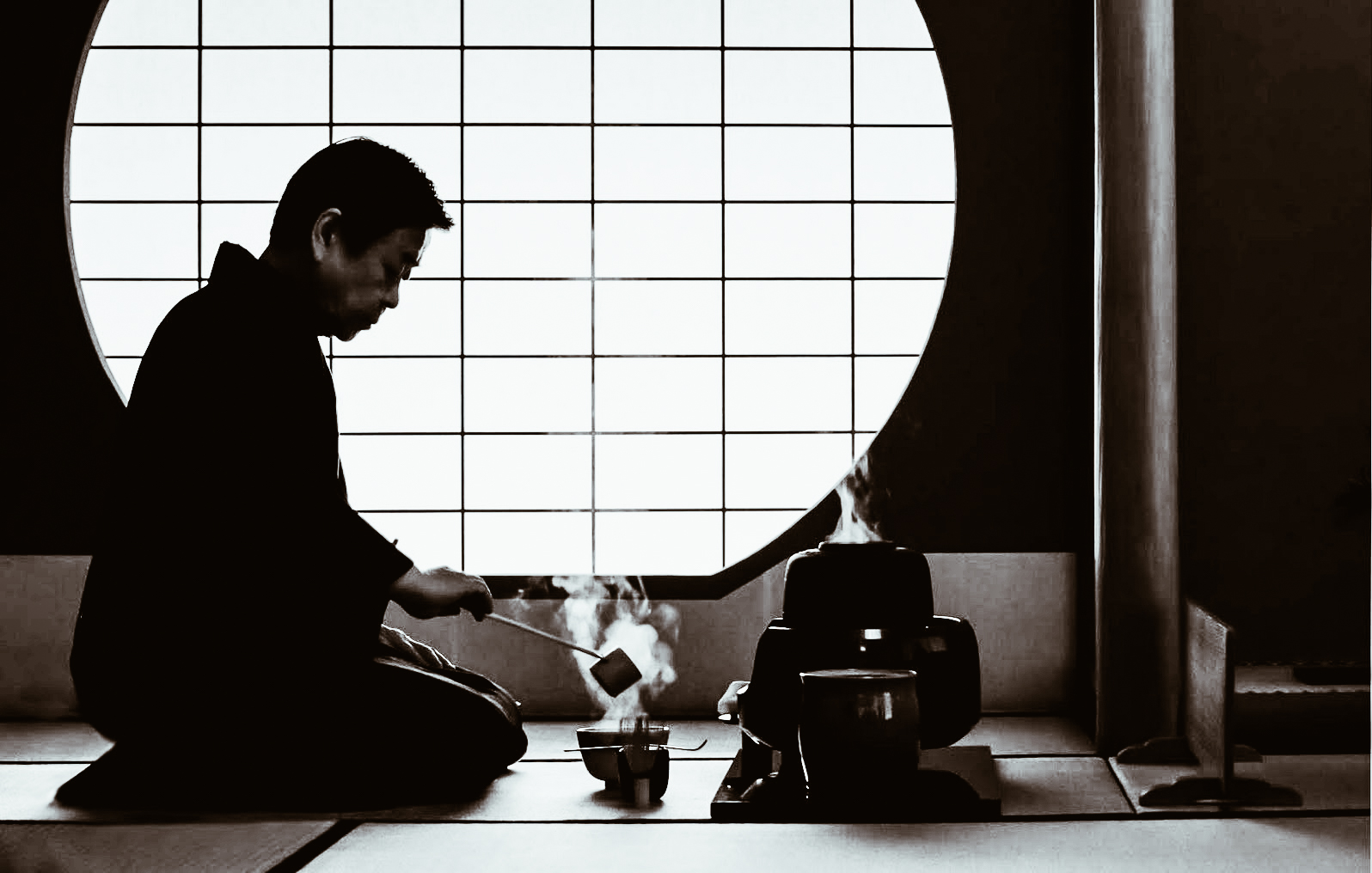
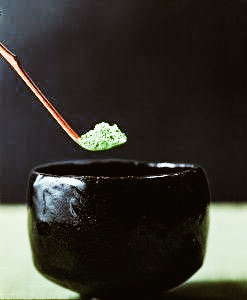
photo credits: pinterest.co.kr, pinterest.it
茶会 Chakai
- Before tea. Here the guests receive only the traditional Wagashi sweets, specifically: Higashi (dry sweets) if Usucha is served, Omogashi (soft sweets) if Koicha is served. In any case, the dessert will have to compensate for the bitter taste of the matcha.
- Koicha or Usucha. As the time available is shorter, only one of the two modes can be presented. It will then be up to the teishu (master of ceremonies) to decide which one to perform.
Everything concerning the behaviour to be held or not during the ceremony is called Otemae (お点前). It is known as "etiquette", but it is much more than that. The very way in which the ceremony is carried out right from the preparations (setting up, cleaning and so on) already constitutes the Tea Route. And therefore, the Otemae.
Ways within the Way, Art within Art
The Tea Route is emblematic. For in itself it contains other forms of art that already constitute a world of their own. Other Paths that intersect and unfold in that of Tea creating a unique association where that perfect fusion - mentioned above - is already taking shape. The artisan technique of Raku ceramics, for example, is perfect for embodying the Zen spirit of the Tea Route: in extracting the still incandescent cups from the kiln, it enhances the naturalness of the irregular shapes randomly generated.
The marvellous art of the Wagashi has evolved parallel to Chadō, finding in it its maximum expression. Influenced by the Yin and Yang philosophy and the five elements, its designs and colours inspired by nature and seasons promise an awakening of the five senses. We also include Chakaiseki (茶懐石, Kaiseki kitchen applied to Chadō), Chabana (茶花, Ikebana applied to Chadō), the architecture itself. Even poetry: among the possible verbal interactions there is the possibility for the landlord to quote a Haiku (typical poetic composition) for seasonal reference. They all remind us that things also have a spirit. And that it must be nurtured, respected, contemplated... just like ours.
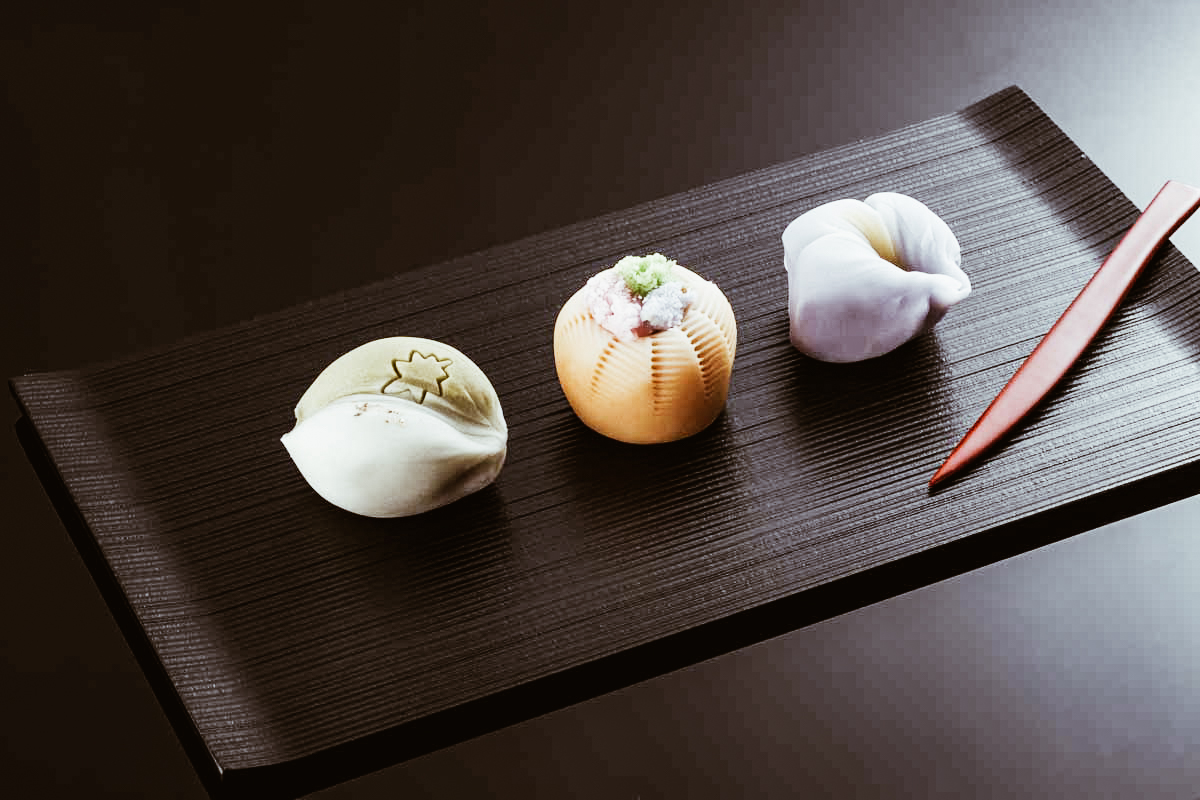
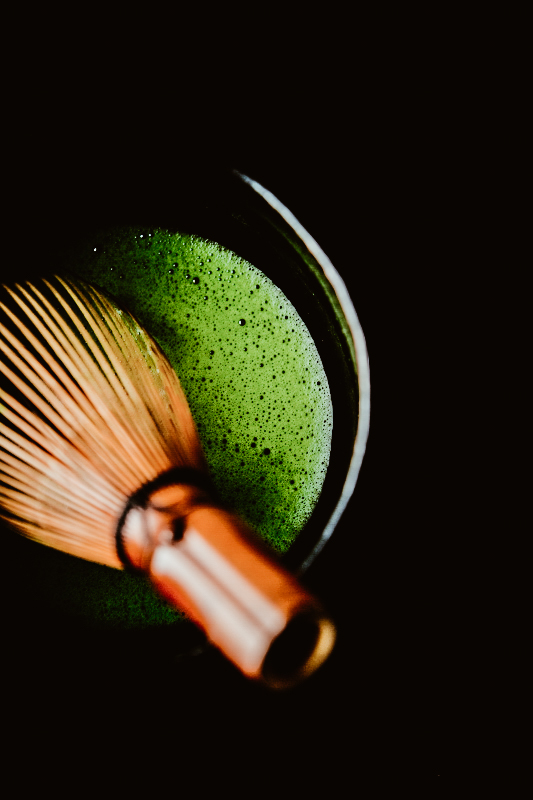
photo credits: sweetsofjapan.com, Flickr
A universe enclosed in a single cup of tea
The Tea Ceremony is, therefore, a meditative practice to all effects that with the "excuse" of a cup of tea leads us to the doorway of our Consciousness. This intent is at the basis of all Japanese art forms: to use earthly things without being harnessed by them. Knowing how to seek, feel, the spirit within the earthly experience inevitably included in it. The key is not to exclude it, but simply not to be harnessed by it.
As a little girl, I myself did not understand the necessity of having to make all those gestures. Now, after experiencing a particular state of emptiness simply thanks to a pair of chopsticks (hashi), everything became crystal clear to me. Understanding in my heart the loving act of these people, in trying to express this truth. That is why only by experiencing it in person can you truly understand.
As of today, in fact, the main Chadō schools come from the descendants of Sen no Rikyū and are the Omotesenke, the Urasenke and the Mushanokojisenke. They present technical and stylistic differences that however do not affect what is the spirit at the base of Cha no Yu. There are also other minor schools. Among these: the Oribe-ryū descending from Furuta Oribe (successor pupil of Rikyū) and the Yabunouchi-ryū founded instead by such Yabunouchi Kenchū Jōchi who was a disciple of Takeno Jōōō as Sen no Rikyū.
Finally, it is worth mentioning the lesser-known Senchadō (煎茶道), the variant "for infusion" of Cha no Yu, which uses the precious green tea leaves. More recent than Chadō, it is born with a more convivial tone and less "spiritually committed", although it is inspired in several aspects. However, it differs in that it is less rigid and more focused on aesthetic pleasure and fine utensils.







